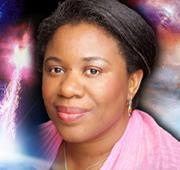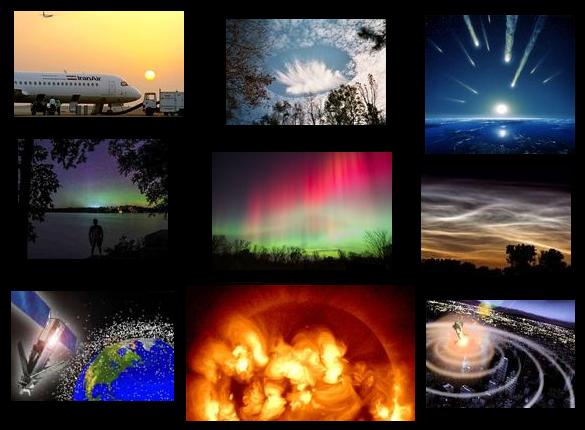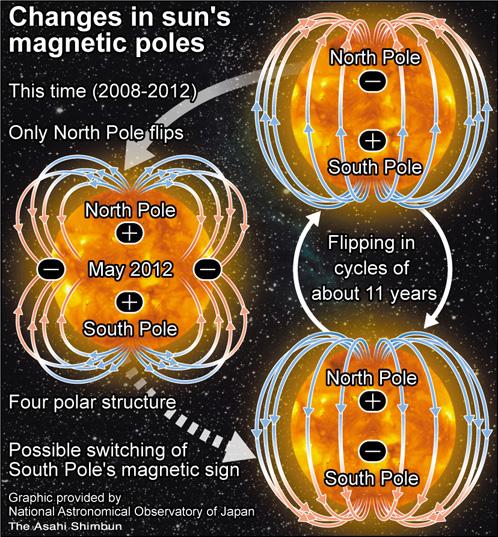Best of the Blog - The Sun Archives
Giant Convection Cells Found on the Sun
WUWT News, 5th December 2013
Sun Will Flip Upside Down Within Weeks - NASA
Independent News, 15th November 2013

The sun is set to “flip upside down” within weeks as its magnetic field reverses polarity in an event that will send ripple effects throughout the solar system.
Although it may sound like a catastrophic occurrence, there’s no need to run for cover. The sun switches its polarity, flipping its magnetic north and south, once every eleven years through an internal mechanism about which little is understood.
The swap could however cause intergalactic weather fronts such as geomagnetic storms, which can interfere with satellites and cause radio blackouts. [...]
Todd Hoeksema, director of the Wilcox Solar Observatory, said the polarity change is built up throughout the eleven year cycle through areas of intense magnetic activity known as sunspots which gradually move towards the poles, eroding the existing opposite polarity.
Eventually, the magnetic field reduces to zero, before rebounding with the opposite polarity. “It's kind of like a tide coming in or going out,” Hoeksema said. “Each little wave brings a little more water in, and eventually you get to the full reversal.”
Comment: The headline is misleading. The sun is not going to flip, the sun's magnetic field polarity at the poles is going to flip and the simple explanation here for how it happens is quite useful. Whatever, solar scientists have been weatching and scratching their heads for a long time because this solar cycle has been a major eniggma, and the switch has been a long drawn out and bizarre affair. See archives for more background info. What concerns me here is the attempt to blame the magnetic polarity swap causing " intergalactic weather fronts" I have never come across such drivel in the mainstream media concerning space weather... Shameful reporting. Maybe this is another poor attemp at blaming anything other than cometary 'action at a distance' effects on the Sun.
Strange doings on the sun
Wall Street Journal, 10th November 2013
Something is up with the sun. Scientists say that solar activity is stranger than in a century or more, with the sun producing barely half the number of sunspots as expected and its magnetic poles oddly out of sync. [...] "I would say it is the weakest in 200 years," said David Hathaway, head of the solar physics group at NASA's Marshall Space Flight Center in Huntsville, Ala.
Researchers are puzzled. They can't tell if the lull is temporary or the onset of a decades-long decline, which might ease global warming a bit by altering the sun's brightness or the wavelengths of its light.
Comment: Hmmmm.... This tells us that solar scientists are at a complete loss trying to understand what is happening on our Sun. All the talk of solar maximum is just desperation, and it seems the current solar activity is due to electrical interference from comets.
Sun Mysteriously Goes All Quiet Just When Its Activity Should Be Highest
Wired News, 16th September 2013
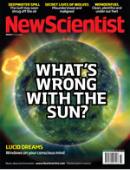
[...] “Quite frankly, we’re not very good at solar cycle predictions,” said Rutledge.
Considering that this solar cycle is the weakest in more than a century, some researchers are already predicting that it could be the start of an ebb in overall activity, with several more low cycles ahead. The website spaceweather.com, which monitors the sun’s activity, also suggested that this lull could signal a double-peaked solar cycle whose valley we are currently experiencing. But Rutledge pointed out that our fundamental understanding of how the sun works is still incomplete. The sun could remain quiet or an uptick in activity, including the possibility of extreme space weather, could come at any time.
Comment:
The final sentence is rather curious: "Within a week or so, solar activity should return to normal." So what exactly does Rutledge think is going to trigger the Sun from its lowest ebb in a century? Comet ISON?
Sun-watching satellite captures suicidal comet and massive solar explosion
Yahoo, 20th August 2013

The NASA/ESA Solar and Heliospheric Observatory (SOHO) caught a spectacular view early this morning, spying not only a small comet making a death-dive into the sun, but also an immense coronal mass ejection being blown off into space.
As you can see in the video, the comet comes in from the lower right. Depending on how you look at it, it almost seems like either the comet sets off the massive 'full-halo' coronal mass ejection that we see, or the massive CME destroys the comet. However, the comet and the CME are actually on completely different sides of the sun, so they never interact.
Comment: So the massive CME blast was just a coincidence then? NASA scientists obviously have never heard of comets and "action at a distance...." Whats more,they would have to be really stupid to be not worried about what could happen when Comet ISON scrapes the Sun in November 2013... see archives for the background story. See also the pathetic denials at spaceweather.com
SUNDIVING COMET AND FULL-HALO CME:
Sun's Magnetic Field Flip Won't Doom Earth, Scientists Say
Space.com, 7th August 2013
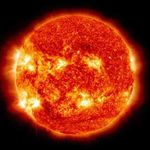
We have nothing to fear from the big change that is about to occur on the sun, researchers stress.
The sun's magnetic field is set to reverse its polarity in the next few months. But the shift won't spark an increase in powerful solar storms or other events that could have a damaging effect on Earth and its inhabitants, researchers say.
"The world will not end tomorrow," Phil Scherrer, a solar physicist at Stanford University, told SPACE.com. [Solar Magnetic Field Will Soon Flip (Video)]
This polarity flip is perfectly normal solar behavior, occurring every 11 years at the peak of our star's activity cycle. But the field reversal doesn't drive the increase in solar flares and eruptions of superheated plasma, called coronal mass ejections, that is observed around solar max.
Comment: Presumably, this is a response to the smoke screen of distractions on numerous conspiracy websites intended to stop people paying attention to Comet ISON, which some experts believe will provide put on a spectacular cosmic display in the heavens.
Magnetic Reconnection: The Heart Of Space Weather In The Sun Observed In Action
Science 2.0 News, 16th July 2013
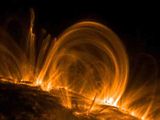
NASA's Solar Dynamics Observatory and the Reuven Ramaty High Energy Solar Spectroscopic Imager have provided the most comprehensive movie ever of a mysterious process at the heart of all explosions on the sun: magnetic reconnection.
Magnetic reconnection happens when magnetic field lines come together, break apart and then exchange partners, snapping into new positions and releasing a jolt of magnetic energy. This process lies at the heart of giant explosions on the sun, such as solar flares and coronal mass ejections, which can fling radiation and particles across the solar system.
Comment: The stupid concept of magnetic reconnection where imaginary lines of magnetic force are supposed to "break". We are talking about huge electric currents held in place by magnetic fields. See archives for more info and links.
-
Article 4 : “No” to Magnetic Reconnection and “Yes” to Electrified Plasma
Thunderbolts.info, 24th December 2011
Electrical engineers and plasma cosmologists have been known to say that magnetic reconnection is one of the stupidest theoretical ideas that researchers ever derived from the mistaken belief that there are no significant electric currents in space. Yes, the mathematics can be made to fit – though with increasing difficulty as observations proceed – with the energy needs involved, but it should be remembered that processes of physics are not explained by such equations. However, in the case of “magnetic reconnection” there is a much deeper difficulty than that. I refer to the inconvenient truth that the lines of force of a magnetic field do not physically exist at all! They are only a mental aid for us to conceptualise the shape and intensity of a magnetic field.
Sun's 2013 Solar Activity Peak Is Weakest in 100 Years
Space.com, 12th July 2013
The Sun has a strange magnetic outbreakspaceweather.com, 13th June 2013
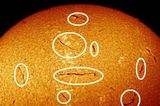 AN OUTBREAK OF MAGNETIC FILAMENTS:
AN OUTBREAK OF MAGNETIC FILAMENTS: The sunspot number may be low, but the sun is far from blank. Amateur astronomers monitoring the sun report a large number of magnetic filaments snaking across the solar disk. Sergio Castillo captured more than half a dozen in this picture he sends from his backyard observatory in Inglewood, California:
"Filaments are popping up all over the solar surface," says Castillo. "Each one has a unique shape and length."
The longest one, in the sun's southern hemisphere stretches, more than 400,000 km from end to end. "It's one of the longest filamentary structures I have ever seen," says veteran observer Bob Runyan of Shelton, Nebraska.
If any of the filaments collapses, it could hit the stellar surface and explode, producing a Hyder flare. Filaments can also become unstable and erupt outward, hurling pieces of themselves into space. Either way, astronomers with solar telescopes are encouraged to monitor developments.
Comment: Lets just watch and see what happens...
Researchers explain magnetic field misbehavior in solar flares
Phys.org News, 22nd May 2013
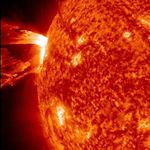
When a solar flare filled with charged particles erupts from the sun, its magnetic fields sometime break a widely accepted rule of physics.
The flux-freezing theorem dictates that the magnetic lines of force should flow away in lock-step with the particles, whole and unbroken. Instead, the lines sometimes break apart and quickly reconnect in a way that has mystified astrophysicists. [...]
The flux-freezing theorem was developed 70 years ago by Hannes Alfvén, who later won a Nobel Prize in physics for closely related work. His principle states that magnetic lines of force are carried along in a moving fluid like strands of thread cast into a river, and thus they can never "break" and reconnect. But scientists have discovered that within violent solar flares, the principle does not always hold true. Studies of these flares have determined that their magnetic field lines sometimes do break like stretched rubber bands and reconnect in as little as 15 minutes, releasing vast amounts of energy that power the flare.
"But the flux-freezing principle of modern plasma physics implies that this process in the solar corona should take a million years!" Eyink said. "A big problem in astrophysics is that no one could explain why flux-freezing works in some cases but not others."
Comment: This is some backward solar scientists finally admitting what plasma physicists have known for over 45 years and that is magnetic fields are not "frozen-in". Hannes Alfvén, Professor of Electrical Engineering & Plasma Physics, towards the end of his career realised he was wrong and in 1970, at his Nobel Prize lecture he stated: “It is only the plasma that does not ‘understand’ how beautiful the theories are and absolutely refuses to obey them.” Space weather predictions are needed based on reality because our real technological world is in peril. This announcement tells us that the powers that be are kicking backsides to force academic types to move the science on, fantasy theory is not good enough.
Researchers reveal model of Sun's magnetic field
Phys.Org News, 22nd May 2013
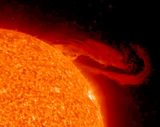
The research, published in the journal Nature, explains how the cyclical nature of these large-scale magnetic fields emerges, providing a solution to the mathematical equations governing fluids and electromagnetism for a large astrophysical body.
The mechanism, known as a dynamo, builds on a solution to a reduced set of equations first proposed in the 1950s which could explain the regular oscillation but which appeared to break down when applied to objects with high electrical conductivity. The mechanism takes into account the 'shear' effect of mass movement of the ionised gas, known as plasma, which makes up the Sun. More importantly it does so in the extreme parameter regime that is relevant to astrophysical bodies.
Comment: I think this is another reality bite... Admitting that the laws of electromagnetism dominate the big ball of plasma we call the Sun is a big step for these scientists.... /sarc off
Solar cycle update – sun’s magnetic activity still in a slump
WUWT, 7th May 2013
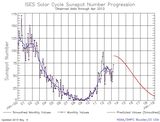
Despite some small upticks on sunspot and 10.7cm radio activity, the magentic activity of the sun is still bumping along the bottom. A slight uptick was seen in sunspot count. [...]
Solar scientist David Hathaway has updated his prediction page on 5/1/13:
The current prediction for Sunspot Cycle 24 gives a smoothed sunspot number maximum of about 66 in the Fall of 2013. The smoothed sunspot number has already reached 67 (in February 2012) due to the strong peak in late 2011 so the official maximum will be at least this high and this late. We are currently over four years into Cycle 24. The current predicted and observed size makes this the smallest sunspot cycle since Cycle 14 which had a maximum of 64.2 in February of 1906.
Comment: The Sun is in a big slump but if it is approached by a big comet the result is MASSIVE flares and/or Coronal Mass Ejections as we saw in March 2013 with Comet Pan-STARRS. I have now come to the conclusion that the real fear of solar max in 2012 has morphed into real fear concerning the arrival of sungrazer Comet ISON that on November 28, 2013, will fly through the sun's outer atmosphere only 1.2 million km from the stellar surface below. I imagine there is a huge community of space scientists, scientists, engineers and intelligentsia in fear and trepidation. If people are not frightened it is because they are oblivious to the seriousness of the situation.
-
VIRAL: Watch three years of Sun in three minutes
WTVR News, 23rd April 2013
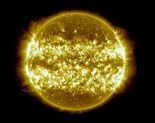 GREENBELT, Md. (NASA GODDARD) – In the three years since it first provided images of the sun in the spring of 2010, NASA’s Solar Dynamics Observatory (SDO) has had virtually unbroken coverage of the sun’s rise toward solar maximum, the peak of solar activity in its regular 11-year cycle. This video shows those three years of the sun at a pace of two images per day.
GREENBELT, Md. (NASA GODDARD) – In the three years since it first provided images of the sun in the spring of 2010, NASA’s Solar Dynamics Observatory (SDO) has had virtually unbroken coverage of the sun’s rise toward solar maximum, the peak of solar activity in its regular 11-year cycle. This video shows those three years of the sun at a pace of two images per day.
SDO’s Atmospheric Imaging Assembly (AIA) captures a shot of the sun every 12 seconds in 10 different wavelengths. The images shown here are based on a wavelength of 171 Angstroms, which is in the extreme ultraviolet range and shows solar material at around 600,000 Kelvin. In this wavelength it is easy to see the sun’s 25-day rotation as well as how solar activity has increased over three years.
-
Three Years of SDO Images
NASA Science News, 22nd April 2013
In the three years since it first provided images of the sun in the spring of 2010, NASA’s Solar Dynamics Observatory has had virtually unbroken coverage of the sun's rise toward solar maximum, the peak of solar activity in its regular 11-year cycle. This video shows those three years of the sun at a pace of two images per day.
Computer simulation shows the sun's "heartbeat" is magnetic
Phys.Org News, 5th April 2013

(Phys.org) —A research team made up of Paul Charbonneau, a physicist with the University of Montreal and Piotr Smolarkiewicz, a weather scientist with the European Centre for Medium-Range Weather Forecasts in the U.K., has created a new kind of computer simulation of the sun's energy flow. In their Perspective article published in the journal Science, the two describe the solar engine deep within the sun as its "heartbeat" and suggest that it underlies virtually all solar activity.
To gain a better understanding of how the sun works, the two researchers created a simulation that models the sun's entire magnetic field activity—no small feat. They ran their simulation on University of Montreal supercomputers which are connected to a larger network across the city. In so doing, they observed that though the sun as a whole experiences an 11 year cycle of solar polar reversals (as noted here on Earth by the periodic nature of observable sun spot activity), zonal magnetic field bands undergo a polarity reversal on average every 40 years.
Slumbering Sun Should Wake Up This Year
Space.com, 22nd March 2013
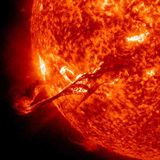
The sun should roar back to life sometime in 2013, producing its second activity peak in the last two years, scientists say.
Our star has been surprisingly quiet since unleashing a flurry of flares and other eruptions toward the end of 2011. But this lull is likely the trough between two peaks that together constitute "solar maximum" for the sun's current 11-year activity cycle, researchers say.
"If you look back in history, many of the previous solar cycles don't have one hump, one maximum, but in fact have two," solar physicist C. Alex Young, of NASA's Goddard Space Flight Center in Greenbelt, Md., said today (March 22) during a NASA webcast called "Solar MAX Storm Warning: Effects on the Solar System."
Comment: As I have already stated, the sun is confounding the solar experts BUT after Comet PanStarrs caused a huge CME blowout at a distance when it passed the ecliptic, the sungrazer Comet ISON is now more expected to ignite the Sun and this is causing solar scientists to worry about providing some warning about extreme solar activity and some bad space weather that might come our way.
Solar Cycle Update: Twin Peaks?
NASA Science News, 1st March 2013
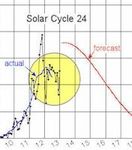
March 1, 2013: Something unexpected is happening on the sun. 2013 is supposed to be the year of Solar Max, the peak of the 11-year sunspot cycle. Yet 2013 has arrived and solar activity is relatively low. Sunspot numbers are well below their values in 2011, and strong solar flares have been infrequent for many months. [...]
Given the tepid state of solar activity in Feb. 2013, a maximum in May now seems unlikely.
"We may be seeing what happens when you predict a single amplitude and the Sun responds with a double peak," comments Pesnell.
Incidentally, Pesnell notes a similarity between Solar Cycle 24, underway now, and Solar Cycle 14, which had a double-peak during the first decade of the 20th century. If the two cycles are in fact twins, “it would mean one peak in late 2013 and another in 2015.”
No one knows for sure what the sun will do next. It seems likely, though, that the end of 2013 could be a lot livelier than the beginning.
Comment: Oh dear.... the saga of the pitiful solar cycle 24 drags on and the guessing game continues... BUT Comet ISON is coming and some believe it is very likely to excite the Sun, hence the speculation and rumour-mongering about twin peaks...
-
How long to the 24/25 solar minimum?
WUWT, 5th March 2013
Altrock noted that Solar Cycle 24 was 40% slower than the average of the previous two cycles. That means that it is going to be 40% longer and that is borne out by the diagram. [...] On this line of evidence, Solar Cycle 24 will be 17 years long and the longest solar cycle for 300 years.
Space Weather: Solar probe untangles riddle of flux ropes
SEN News, 2nd February 2013

A NASA space telescope has finally confirmed to solar scientists the processes that produce massive explosions on the Sun. A flare on 18 July, 2012, allowed the Solar Dynamics Observatory to watch the development of a sequence of events that led to a classic eruption termed a Coronal Mass Ejection (CME).
The pattern observed supported a theory that the scientists had long thought to be responsible - the formation of something termed a flux rope as magnetic field lines in the Sun's corona began to twist about, generating a coil of the hottest material on the Sun, a charged gas called plasma. [...]
Angelos Vourlidas, a solar scientist at the Naval Research Laboratory in Washington, D.C. said:
"Seeing this structure was amazing. It looks exactly like the cartoon sketches theorists have been drawing of flux ropes since the 1970s. It was a series of figure eights lined up to look like a giant slinky on the Sun."
Comment: You would think reading this press release that scientists have not been observing the behaviour of plasma in the laboratory for about 130 years. Plasma scales up over millions of orders of magnitude and features that are 100 million times bigger than prominences found on the sun can be found at the galactic centre... This press release should say: the sun is a ball of plasma and the plasma on the surface behaves like plasma... Nothing unusual to report...
Solar Variability and Terrestrial Climate
NASA Science News, 8th January 2013
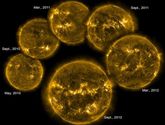
In the galactic scheme of things, the Sun is a remarkably constant star. While some stars exhibit dramatic pulsations, wildly yo-yoing in size and brightness, and sometimes even exploding, the luminosity of our own sun varies a measly 0.1% over the course of the 11-year solar cycle.
There is, however, a dawning realization among researchers that even these apparently tiny variations can have a significant effect on terrestrial climate. A new report issued by the National Research Council (NRC), "The Effects of Solar Variability on Earth's Climate," lays out some of the surprisingly complex ways that solar activity can make itself felt on our planet.
Understanding the sun-climate connection requires a breadth of expertise in fields such as plasma physics, solar activity, atmospheric chemistry and fluid dynamics, energetic particle physics, and even terrestrial history. No single researcher has the full range of knowledge required to solve the problem. To make progress, the NRC had to assemble dozens of experts from many fields at a single workshop. The report summarizes their combined efforts to frame the problem in a truly multi-disciplinary context.
One of the participants, Greg Kopp of the Laboratory for Atmospheric and Space Physics at the University of Colorado, pointed out that while the variations in luminosity over the 11-year solar cycle amount to only a tenth of a percent of the sun's total output, such a small fraction is still important. "Even typical short term variations of 0.1% in incident irradiance exceed all other energy sources (such as natural radioactivity in Earth's core) combined," he says.
Comment: Well, NASA scientists are realising that the CO2 hoax cannot be sustained and we are getting some major new admissions of reality.... reality bites... In summary, Space Weather is generating a full blown planetary emergency, out-dated ideas from the dark ages are no longer appropriate... see more technical comments at WUWT and lots of previous comments on this blog.
NASA on the sun: ‘…tiny variations can have a significant effect on terrestrial climate.”
Watts Up With That?, 8th January 2013
Is there a planetary influence on solar activity? It seems so according to this new paper
WUWT, 10th November 2012
 Long suspected, it seems that this has now been confirmed by a paper in Astronomy and Astrophysics with the title “Is there a planetary influence on solar activity?” by Abreu et al that was published on 22nd October, 2012.
Long suspected, it seems that this has now been confirmed by a paper in Astronomy and Astrophysics with the title “Is there a planetary influence on solar activity?” by Abreu et al that was published on 22nd October, 2012. [...]
The idea that planetary motions may influence solar activity seems to have been initiated by Rudolf Wolf in the 1850s. While energy considerations clearly show that the planets cannot be the direct cause of solar activity, they may perturb the solar dynamo. [...]
Specifically, the authors calculated planetary torque at the tachocline. The tachocline of the sun is a shear layer which represents a sharp transition between two distinct rotational regimes: the differentially rotating convection zone and the almost rigidly rotating radiative interior. The tachocline plays a fundamental role in the generation and storage of the toroidal magnetic flux that eventually gives rise to solar active regions. A net tidal torque is exerted in a small region close to the tachocline due to the buoyancy frequency originating from the convection zone matching the tidal period. [...]
If planetary torque modulates solar activity, does solar activity in turn modulate the earth’s climate? Let’s have a look at what the 10Be record is telling us. This is the Dye 3 record from Greenland:
Conclusion:
This paper is a major advance in our understanding of how solar activity is modulated and in turn its effect on the earth’s climate. It can be expected that planetary torque will progress to being useful as a tool for climate prediction – for several hundred years ahead.
Reference:
J.A. Abreu, J. Beer, A. Ferriz-Mas, K.G. McCracken, and F. Steinhilber, Is there a planetary influence on solar activity?” Astronomy and Astrophysics, October 22, 2012. Download .pdf
here.
Comment: Interesting.... we get some new science related to the recently discovered tacholine... Concerning the fact it has been over 150 years since some astronomers suspected the planets influenced the behaviour of the Sun, the website
www.justgoodtiming.com, has a collection of references concerning the influence of the planets on the Sun and us humans. This was traditionally generally ignored in the scientific world because of the link with astrology and electromagnetism, but it has not been ignored by some geoscientists who are adamnant that planetary alignments electromagenetically induce earthquakes, see the Geocataclysm 2011 report. For that matter,
Comet Holmes was clearly ignited by an alignment of 3 planets but many astronomers are still living in the dark ages and refuse to acknowledge the electromagnetic force that is 39 orders of magnitude stronger than gravity.... Thus this paper is a major challenge to the status quo by suggesting that planetary alignments can be used to predict the Earth's climate.... And just to confirm this viewpoint, this paper was rejected by the pro-establismment Nature Journal...
-
Solar Activity – Past, Present, Future
Essay/paper by Dr. Leif Svalgaard
WUWT, 11th November 2012
As our civilization depends increasingly on space-borne assets and on a delicate and vulnerable earth-bound infrastructure, solar activity and its potential impact becomes of increasing importance and relevance. In his famous paper on the Maunder Minimum, Eddy (1976) introduced the notion that the Sun is a variable star on long time scales. After the recent decade of vigorous research based on cosmic ray and sunspot data as well as on geomagnetic activity, an emerging consensus reconstruction of solar wind magnetic field strength has been forged for the last century.
Solar maximum? Oh, you just missed it
New Scientist, 26th September 2012
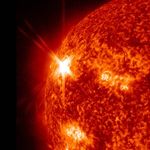
WAITING for solar fireworks to reach a grand finale next year? Um, sorry, looks like you already missed them. Structures in the sun's corona indicate that the peak in our star's latest cycle of activity has been and gone, at least in its northern hemisphere.
The southern hemisphere, meanwhile, is on a sluggish rise to solar maximum and may not hit its peak until 2014.
This bizarre asymmetry strengthens a theory that has been bubbling among sun watchers for the past few years: our star is headed for hibernation. Having the sun's outbursts turned off for a while would provide a better baseline for studying how they influence Earth's climate. [...]
Based on the movements of this cycle's prominences, Altrock says that an especially weak solar maximum took place in the sun's northern hemisphere around July last year (arxiv.org/abs/1209.2969).
Bernhard Fleck, project scientist for NASA's and the European Space Agency's Solar and Heliospheric Observatory, calls the paper solid work, but adds that even if we missed the northern maximum, the southern hemisphere is still expected to put on a show.
According to Altrock, the southern prominences are still on the move, but slowly. If they continue at the current rate, he says, the south will not reach its maximum until February 2014.
Comment: Sigh.... The military solar scientists were more right about a weak Sun but their opinion was completely ignored by NASA spokesman, solar scientist David Hathaway, who championed a mega solar max in 2012, see archives for more info. There has been a swift response to this from Dr. Leif Svalgaard on the New Scientist solar max story over at WUWT who also made predictions that were more right and of course, Svalgaard et al. were ignored too.
Dr. Leif Svalgaard on the New Scientist solar max story
WUWT, 28th September 2012
NASA's Solar Fleet Peers Into Coronal Cavities
NASA Science News, 20th September 2012
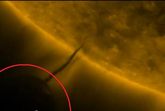
[...] Kucera and her colleagues have published a paper in the Sept. 20, 2012, issue of The Astrophysical Journal on the temperatures of the coronal cavities. This is the third in a series of papers -- the first discussed cavity geometry and the second its density -- collating and analyzing as much data as possible from a cavity that appeared over the upper left horizon of the sun on Aug. 9, 2007 (below). By understanding these three aspects of the cavities, that is the shape, density and temperature, scientists can better understand the space weather that can disrupt technologies near Earth.
Comment: Sun watchers in the blogosphere have already been wondering about these black cavities, see the incredible SDO video link below. This discovery just goes to show that there are new and surprising things still being discovered about our sun and the emphasis on space weather is an excuse to do some intensive analysis.
Solar filament snapping closeup SUN 2012 03 12
YouTube, 13th March 2012
March 11-12 2012: all 88 frames from SDO 171, SW quadrant, excluding blank frames. Cropped from 4096x4096 full frame images. Shows dark filament and solar prominence cavity. Filament "snaps" resulting in a "splash" on the surface
Charged vortices erupting from the Sun can form relatively dark cavities.
Thunderbolts.info, 20th September 2012
Recently, much has been made about a so-called “black sphere connected to the Sun.” Outlandish claims that a solid object was in close solar orbit, “feeding” off the photospheric plasma, have appeared in various places on the internet. [...] Laboratory experiments with a positively charged sphere show that a plasma torus forms above the Sun’s equator. Electric discharges known as sunspots sometimes bridge the torus with the Sun’s middle and lower latitudes, punching holes through the photosphere.
Comment: What Stephen Smith is saying is that he thinks the black cavity is associated with plasma torus ring around the equator. Some Electric Universe/Sun theorists believe the data from SOHO ultraviolet images proves the torus exists and I did briefly mention this in my e-book
The Electrotechnics of the Heavens. Yes, I know Smith then moves on to explain plasma behaviour generally on the Sun, but a large dark filament hanging off the main torus connected to a sunsport by a bridge of plasma would be a nice simple Electric Sun explanation... We will see how long it takes for mainstream astronomers to come up with the same explanation... Any bets?
Link Between Coronal Mass Ejections And The Sun’s Interior Motion
Red Orbit, 25th September 2012
SOON AND BRIGGS: Global-warming fanatics take note
Washington Times, 6th September 2012

Scientists have been studying solar influences on the climate for more than 5,000 years.
Chinese imperial astronomers kept detailed sunspot records. They noticed that more sunspots meant warmer weather. In 1801, the celebrated astronomer William Herschel (discoverer of the planet Uranus) observed that when there were fewer spots, the price of wheat soared. He surmised that less light and heat from the sun resulted in reduced harvests.
Earlier last month, professor Richard Muller of the University of California-Berkeley Earth Surface Temperature (BEST) project announced that in the project’s newly constructed global land temperature record, “no component that matches solar activity” was related to temperature. Instead, Mr. Muller said carbon dioxide controlled temperature.
Comment: All life on this planet is dependent on the Sun, so climate scientists trying to ignore the Sun and force change based one small component that has a minuscle representation in Earth's atmosphere verges on lunacy. Personally, I believe there is a far more esoteric reason why world controllers want to get rid of the carbon dioxide (CO
2) in the atmosphere. My research suggests that in the near future, the CO
2 will combine with the recently charged up cosmic environment to reveal that our planet has arrived at a new dispensation. Earth's status will return to 'Paradise' and it will be downright undeniable when it happens.
-
Discovery News Category 6 hurricanes – ‘batshit stupid’
WUWT, 4th September 2012
"Hurricane expert Dr. Ryan Maue pulls no punches when it comes to putting John Abraham of the Climate Science Rapid Response Team in his place:"
Comment: This is a rebuttal to the lastest desperate attempt to steer public opinion. It does makes a nice change when scientists use language that everyone can understand....
The sun – still slumping
WUWT, 3rd September 2012
Prelude to an X-Class solar flare (VIDEO)
PhysOrg.com News, 17th July 2012
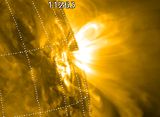
What takes place on the Sun before it unleashes a huge solar flare? It’s a thing of beauty, and observations from the Solar Dynamics Observatory are helping scientists understand how magnetic energy on the Sun creates these giant explosions. Below is a video that shows all the activity on the Sun before it emitted a huge X 1.4- class solar flare on July 12, 2012.
NASA | Dynamic Earth
YouTube, 19th June 2012
NASA animation shows the sun blasting out a giant explosion of magnetic energy called a coronal mass ejection and the Earth being shielded from this by its powerful magnetic field.
Scientist Finds Hidden Portals in Earth’s Magnetic Field
Gizmodo News, 3rd July 2012
 According to NASA, Jack Scudder—a researcher at the University of Iowa—has found "hidden portals on Earth's magnetic field [that] open and close dozens of times each day." Some of them are open for long periods of time.
According to NASA, Jack Scudder—a researcher at the University of Iowa—has found "hidden portals on Earth's magnetic field [that] open and close dozens of times each day." Some of them are open for long periods of time.
Scudder says that these portals "create an uninterrupted path leading from our own planet to the sun's atmosphere 93 million miles away."
Called X-points or electron diffusion regions, they are located "a few tens of thousands of kilometers from Earth. The portals are created through a process of magnetic reconnection in which lines of magnetic force from both celestial bodies mingle and criss-cross through space. The criss-crossing creates these x-points.
The portals are "invisible, unstable and elusive," opening and closing without any warning. When they open, however, they are capable of transporting energetic particles at high speed from the Sun's atmosphere's to Earth's, causing geomagnetic storms.
Comment: Hmmm.... What exactly are we being told here? Earth's magnetic field can erratically open up big holes that floods Earth with cosmic energy that generate geomagnetic storms..... Quite frankly, we need to be told what this means in terms of Earth's cosmic shielding and whether these portal openings are getting bigger and more frequent...
A Rare Type of Solar Storm Spotted by Satellite
Universe Today, 1st June 2012
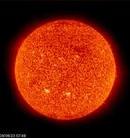
When a moderate-sized M-class flare erupted from the Sun on May 17, it sent out a barrage of high-energy solar particles that belied its initial intensity. These particles traveled at nearly the speed of light, crossing the 93 million miles between the Sun and Earth in a mere 20 minutes and impacting our atmosphere, causing cascades of neutrons to reach the ground — a rare event known as a ground level enhancement, or GLE.
The first such event since 2006, the GLE was recorded by a joint Russian/Italian spacecraft called PAMELA and is an indicator that the peak of solar maximum is on the way.
Comment: This is a serious type of space weather.... According to the
The University of Delaware Bartol Research Institute Neutron Monitor Program,
"Ground Level Enhancments -- solar cosmic ray events intense enough to raise radiation levels on Earth's surface." So, I wonder whether this will become a regular part of the Sun's behaviour.... At this stage, we are in completely unknown territory as changes with the Sun could be induced by the Sun's shift into a new cosmic environment.
Giant sunspot could flare up this week
Summit Voice, 9th May 2012
 SUMMIT COUNTY — A giant sunspot, almost 10 times the size of the Earth’s diameter, will likely generate powerful solar storms, with the the first wave of geomagnetic energy expected Wednesday morning.
NOAA’s Space Weather Prediction Center has issued an alert, with a warming for potential geomagnetic activity continuing the next few days.
SUMMIT COUNTY — A giant sunspot, almost 10 times the size of the Earth’s diameter, will likely generate powerful solar storms, with the the first wave of geomagnetic energy expected Wednesday morning.
NOAA’s Space Weather Prediction Center has issued an alert, with a warming for potential geomagnetic activity continuing the next few days. [...]
The latest burst of activity on the sun comes leading up to a June 5 space weather enterprise forum at the National Press Club in Washington, D.C. The theme of this years conference is the expected upcoming solar maximum in 2013 and how it could affect you. More info is online at
http://www.nswp.gov/swef/swef_2012.html
Comment: Below is the NOAA warning:
2012-05-09 13:58 UTC Increased Activity Looming
NOAA Region 1476, now poised just to the east of center on the solar disk, produced an impulsive R1(Minor) Radio Blackout at 1232 UTC (8:32 EDT) today. The region is quite prominent, although just one-third in area of the large regions of the Halloween Storms in 2003, and exhibits a slight degree of magnetic complexity. It will be in direct alignment with earth in a few days, so CME's then would be likely to spawn geomagnetic activity.
The Office of the Federal Coordinator for Meteorology and the National Space Weather Program will host the 2012 Space Weather Enterprise Forum on June 5, 2012, at the National Press Club in Washington, DC. This year's theme is Solar Maximum 2013 – How Space Weather Will Affect You! To learn more and register, please visit the SWEF web site at http://www.nswp.gov/swef/swef_2012.html.
NOAA’s Space Weather Prediction Center
So, the Sun now has two South Poles when in 2000 there was a bizarre senario of two North poles..... Below is a description of the latest strange behaviour of the Sun.
Solar poles to become quadrupolar in May [2012]
The Yomiuri Shimbun, 21st April 2012
Magnetic field polarity at the solar poles will reverse and become quadrupolar in May, meaning positive fields will emerge in the North and South poles and negative fields will emerge on the equator, according to the National Astronomical Observatory of Japan and other institutes.
When a similar phenomenon occurred about 300 years ago, the Earth's average temperature fell slightly.
A research team led by Saku Tsuneta, a professor at the observatory, analyzed solar magnetic fields data using Hinode, an observational satellite, and confirmed that the polarity of the magnetic field at the North Pole began to reverse in July last year.
The researchers also found the magnetic field at the South Pole, which was expected to reverse along with the North Pole, maintained a positive polarity, ensuring the formation of a quadrupole magnetic field.
Solar poles to become quadrupolar in May [2012]
The Yomiuri Shimbun, 21st April 2012
Comment: I don't know why they could only state something happened 300 hundred years ago because it happened in 2000. See below:
A Star with two North Poles
Normally, our star, like Earth itself, has a north and a south magnetic pole. But for nearly a month beginning in March 2000, the Sun's south magnetic pole faded, and a north pole emerged to take its place. The Sun had two north poles. [...]
"The south pole never really vanished," notes Riley. It migrated north and, for a while, became a band of south magnetic flux smeared around the Sun's equator. By May 2000 the south pole had returned to its usual spot near the Sun's southern spin axis--but not for long. In 2001 the solar magnetic field completely flipped; the south and north poles swapped positions, which is how they remain now.
A Star with two North Poles: Sometimes the Sun's magnetic field goes haywire, and the effects are felt throughout the solar system.
NASA Science News, April 22, 2003
Comment: There was also further examples provided at WUWT, see
Astronomers: World may be entering period of global cooling Now, I wonder whether there is some panic because after the strangeness in 2000 we had some big blowouts in 2001 and 2003. [Please note: solar experts describe this as one pole reversing earlier than the other and it does happen but it is the influence on the sun's overall sunspot activity that seems to be an unknown.] In 2003 we had the Halloween Storms and the biggest solar flare in the modern space age (A Not Earth Directed X45) with NASA losing some functionality in 59% of it's satellites... see
Sun's Massive Explosion Upgraded This time things are far more ominous because the interplanetary magnetic field (IMF) polarities are causing magnetic breaches see
A Giant Breach in Earth's Magnetic Field and Earth's magnetosphere (magnetic shielding) is in a far worse condition generally, see
ESA: Multiple rifts in Earth's magnetic shield .... hence the auroras that don't seem to want to go away, see below...
Scientists Stumped By Sun’s Asymmetrically Reversing Magnetic Field
Talking Points Memo, 26th April 2012
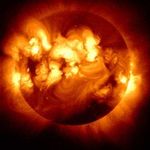
The Sun’s magnetic field is reversing, South becoming North, as it does approximately every 11 years on a cycle, but this time, something even stranger is going on: The North is moving much faster than the South, and space scientists aren’t sure why.
“Right now, there’s an imbalance between the north and the south poles,” Jonathan Cirtain, NASA’s project scientist for a Japanese solar mission called Hinode, in a recent article on NASA’s website. “The north is already in transition, well ahead of the south pole, and we don’t understand why.” [...]
“This usually leads to a double peak in the sunspot number and CME rate as a function of time,” Nat Gopalswamy, a solar scientist
NASA’s Goddard Space Flight Center in Greenbelt, Md., in an email to TPM.
Comment: Hmmmm.... I wonder whether it is possible to date the start of the irregularity with the Sun from 1989, when we had The Great Magnetic Storm during solar cycle 22? At the moment, there are no other candidates because NASA started to notice a decline in the solar wind in the mid 1990s and we had some major blowouts in 1999, 2001 and 2003 during solar cycle 23, where solar maximum seemed to have a double peak with some extraordinary blowouts... Then solar cycle 24 has been just bizarre as it has been extraordinarily quiet with the deepest Solar Minimum in 200 years, combined with some new funny business of another strange magnetic field reversal that also happened in 2001....This solar maximum is causing some major unease because it does not seem to matter if the Sun is quiet, the Sun could still have unleash a super massive blowout whilst our magnetic defences are down.... It only has to happen once during solar maximum for there to be major consequences... I am currently thinking about the naysayers and those who are totally oblivous to what is happening.... We could have a situation where the first that some people realise that our reality has changed for ever is when there is a major geomagnetic storm and all the lights go off and don't come back on EVER.... I realise that most take electricity for granted and are completely oblivious that our dependence on electricity is a major problem, so when and if it disappears, absolutely nothing will work.... Why do you think some can't believe the nonchalant attitude of the totally ignorant people? What is worse is that some scientists are saying this might happen in the next decade or so....No doubt some solar scientists are comparing the strange behaviour of the Sun to previous solar cycles where there have been major geomagnetic storms..... it could be making some very nervous, but as I keep saying, we can't make comparisons because some fundamentals have changed like the state of Earth's magnetic shielding and it seems we could get a major event delivered by not such a major geomagnetic storm...
"The Great Switch" --Sun's Magnetic Field Does a Complete Reverse Every 11 Years
Daily Galaxy, 21st April 2012

The microwave radiation technique described in the second paper makes use of the discovery in 2003 that as the sun moves toward solar maximum, giant eruptions on the sun, called prominence eruptions – which during solar minimum, are concentrated at lower solar latitudes -- begin to travel toward higher latitudes near the poles. In addition, the polar brightness in the microwave wavelengths declines to very low values.
"These prominence eruptions are associated with increased solar activity such as coronal mass ejections or CMEs, so CMEs originating from higher latitudes also point to an oncoming solar maximum," says Nat Gopalswamy. Gopalswamy is a solar scientist at NASA's Goddard Space Flight Center, who is the first author on the microwave observations paper, which was accepted by The Astrophysical Journal on April 11, 2012. "When we start to see prominence eruptions above 60 degrees latitude on the sun, then we know that we are reaching solar maximum."
Comment: More strangeness.... I think the talk of yet another solar model that requires modification is par for the course.... My main interest is whether this allows in more cosmic dust or not but we are not provided with any info here.... the dust, the dust the glorious dust.... sorry, I got a little too excited there.... I am supposed to be depressed.... LOL!
Former NASA Scientists, Astronauts to Attend Heartland Institute Climate Conference
WUWT, 19th April 2012
Wow..... just wow.... I think I am speechless... NASA, you have a problem...
Spectacular Solar Eruption - Biggest Prominence in Years
spaceweather.com, 16th April 2012
 "SPECTACULAR EXPLOSION:
"SPECTACULAR EXPLOSION: Magnetic fields on the sun's northeastern limb erupted around 17:45 UT on April 16th, producing one of the most visually-spectacular explosions in years. NASA's Solar Dynamics Observatory recorded the blast at extreme ultraviolet wavelengths:
Comment: The video is good... there is more comment on the 17th
here.
Sunspot Growing Quickly...
spaceweather.com, 18th April 2012
GROWING SUNSPOT: What a difference a day makes. On April 16th, sunspot AR1460 did not exist. Twenty-four hours later it was twice as big as the planet Earth. This April 17th movie from NASA's Solar Dynamics Observatory shows sunspot genesis in action:
New paper in the Journal of Atmospheric and Solar-Terrestrial Physics demonstrates that planets do not cause solar cycles
WUWT, 16th April 2012
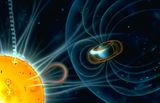
Professor Cornelis de Jager from the Netherlands has put a new publication on his website. It is a study of Dirk K. Callebaut, Cornelis de Jager and Silvia Duhau. They conclude that planetary effects are too small by several orders of magnitude to be a main cause of the solar cycle. A planetary explanation of the solar cycle is hardly possible.
The paper is titled: The influence of planetary attractions on the solar tachocline
Abstract: We present a physical analysis of the occasionally forwarded hypothesis that solar variability, as shown in the various photospheric and outer solar layer activities, might be due to the Newtonian attraction by the planets.
Comment: Interesting.... solar scientists did not even know 'The Tachocline' even existed until a decade or so ago, but now they agreeing that this is where the Sun's magnetic field originates. Here, we have some proper nonsense telling us that the incredibly weak gravitational planetary forces cannot affect something inside the Sun that is supposed to be generating magnetic fields? This kind of 'science' just boggles the mind... I could have told them that and they could have saved themselves some trouble.... At least there is some useful information in the comments. vukcevic says: April 15, 2012 at 11:47 am Not by gravity, but electro-magnetic connection is a definite possibility, showing a promising result with even the simplest of calculations
link That is because the difference between gravity and the electromagnetic force between two electrons is 39 orders of magnitude stronger than the ultra weak force of gravity. Well, it's a slow process, but over the last 12 months or so I have beem writing my latest offering
The Electrotechnics of the Heavens and many more astrophysicists and astronomers are waking up and some are cooperating with plasma physicists. I think this is excellent news. However, you would not know it if you hang out at certain forums where religious fervour for the Electric Universe perspective now seems to have reached fever pitch.
NASA spacecraft spot something new on the sun
Science Daily, 10th April 2012
Comment: Anything new on the Sun should be of great interest because it is more evidence the Sun is processing energy from an external source rather than anything related to the so-called thermonuclear energy core that is suppose to generate constant energy. Most solar scientists must realise this is not what is really going on and the focus has become the plasma and electrodynamic behaviour seen on the sun's surface. This is because space weather is now such a big issue with solar ejections being much more effective than they used to be due to SPACE CLIMATE CHANGE.
The Canyon Fire On The Sun May Spark Geomagnetic Storm On Earth
spaceweather.com, 25th February 2012
 INCOMING CME:
INCOMING CME: Analysts at the Goddard Space Weather Lab say a coronal mass ejection (CME) will hit Earth's magnetic field on Feb. 26th at 13:30 UT (+/- 7 hr). The impact could spark a G2-class geomagnetic storm. Aurora alerts: text, voice.
CANYON OF FIRE: A magnetic filament snaking over the sun's northeastern limb rose up and erupted during the early hours of Feb. 24th. The eruption split the sun's atmosphere creating a "canyon of fire," shown here in a movie captured by the Solar Dynamics Observatory:
The glowing walls of the canyon are
formed in a process closely related to that of
arcade
loops, which appear after many solar flares.
Stretching more than 400,000 km from end to end,
the structure traces the original channel where
the filament was suspended by magnetic forces above
the stellar surface.
As erupting magnetic filaments often
do, this one launched a coronal mass ejection (CME)
into space. The Solar and Heliospheric Observary
recorded the expanding cloud:
movie.
UPDATE:
At first this CME did not appear heading for Earth.
However, a new analysis by forecasters at the Goddard
Space Weather Lab shows that the cloud will indeed
hit Earth's magnetic field on Feb. 26th at 13:30
UT (+/- 7 hr):
animated
forecast track. Geomagnetic storms are possible
when the CME arrives.
Comment: I was interested in this example of solar scientists changing their mind about where a CME was headed...
I Have Never Seen Anything Like These Tornadoes On the Surface of the Sun
Gizmodo, 16th February 2012
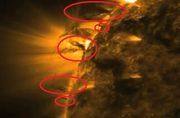
I've seen many sun flares, but I've never seen anything like this video showing several dark plasma tornadoes on the surface of the Sun, captured by the Solar Dynamics Observatory. It's simply mesmerizing and bloody amazing. [...]
Each frame of the video was captured every four minutes for 30 hours, starting on February 7. According to NASA, this kind of video would have never been possible without SDO up in space, which has now been working for two years now.
Comment: Seriously, this is the most amazing video, but the Gizmodo video is better quality but quite short, see YouTube link below for a longer clip... We have many different space probes parked up watching the finest detail possible on the Sun, and then we capture a series of tornadoes. I have not come across solar tornadoes before on the Sun and I am sure Electric Universe proponents will also comment... Maybe it is a sign of the Sun processing a different type of energy in the cosmic environment and reminds me of the black inky type plasma that has been seen exploding on the Sun in more recent times... This might be the YouTube link for the short clip
Solar tornadoes? .
Tornado Season On The Sun?
YouTube, 14th February 2012
"For a 30 hour spell (Feb 7-8, 2012) the Solar Dynamics Observatory captured plasma caught in a magnetic dance across the Sun's surface. The results closely resemble extreme tornadic activity on Earth."
The Filamentary Firmament
Thunderbolts.info, 20th February 2012
Earth in for bumpy ride as solar storms hit
New Scientist, 1st February 2012
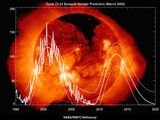 Editorial: "No room for complacency over solar storms"
Editorial: "No room for complacency over solar storms"
THE sun is gearing up for a peak in activity at a time when technology makes our planet more vulnerable to solar outbursts than ever before. Monitoring has improved since the last solar maximum, so what are the big risks this time around?
About once every 11 years, the sun goes ballistic, throwing out more bursts of magnetic activity than normal. As a large but harmless solar flare signalled last week, the next solar maximum is due in 2013. [...]
We can take some comfort in the knowledge that the looming maximum is supposed to be relatively weak, but we shouldn't be complacent. In 1859, during an otherwise weak cycle, a solar storm made telegraph wires spark, starting fires. "You've got the opportunity for flares, and they can be big ones," warns David Hathaway of NASA's Goddard Space Flight Center in Greenbelt, Maryland.
Comment: It's not really the whole story.... Again there is a mention of the 1859 Carrington Event without a direct comparison between previous cycles where there has been some lethal activity, but some solar scientists have spent a lot of time trying to see if there are any correlations... I have written many comments on this subject. In 1859, there were not hundreds of nuclear power stations that need to be powered by electricity 24/7 with only 4-8 hours of diesel engine backups. I am now tired from flogging a dead horse. Please read the archives if you want to know more.
Power-Grid Cyber Attack Seen Leaving Millions in Dark for Months
Bloomberg News, 1st February 2012
400 Chernobyls: Solar Flares, EMP, and Nuclear Armageddon
When Tech Fails, January 2012
This is NOT about scaring people. This is explaining that as our world faces massive changes to the environment due to the new phenomena of space weather, things cannot stay the same. Please note: NASA says there is virtually nothing on the planet that is NOT affected by space weather.
First Estimate of Solar Cycle 25 Amplitude – may be the smallest in over 300 years
WUWTs, 25th January 2012

Predicting the amplitude of Solar Cycle 24 was a big business. Jan Janssens provides the most complete table of Solar Cycle 24 predictions at:
http://users.telenet.be/j.janssens/SC24.html. Prediction activity for Solar Cycle 24 seemed to have peaked in 2007.
Comment: OK, I don't believe we can tell what is going to happen until after the Venus transit because it is now clear that somehow Venus "switched off" the Sun in June 2004 (the long term Ap i.e. the solar geomagnetic index dropped dramatically) and from the snippets of information from metaphysical sources, we can expect the Sun to switch back to normal in June 2012 and start a new proper solar cycle. Personally, I am just curious as to who is right, but I did hear that 2016 and 2017 were going to be rough... Whatever, I am impressed that some scientists did predict a small sunspot cycle, in fact, the smallest in 100 years, but they were wrong, solar cycle 24 was the smallest sunspot cycle in 200 years and now they are saying that solar cycle 25 will be the smallest in 300 years. If I had any spare cash I would bet that the 'experts' are going to be wrong...
Giant Filament - Hyder Flare Candidate
spaceweather.com, 14th November 2011
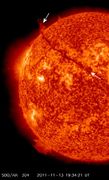 REMARKABLE
SOLAR ACTIVITY:
REMARKABLE
SOLAR ACTIVITY: There haven't
been any strong solar flares in days. Nevertheless,
some impressive activity is underway on the sun.
For one thing, an enormous wall of plasma is towering
over the sun's southeastern horizon. Stephen Ramsden
of Atlanta, Georgia, took this picture on Nov. 11th:
"Solar forums all over the world
are buzzing with Sun-stronomers proclaiming this
to be the biggest prominence that many of them had
ever witnessed," he says.
Remarkably, though, this is not the
biggest thing. A dark filament of magnetism is snaking
more than halfway around the entire sun:
SDO
image.
From end to end, it stretches more than
a million km or about three times the distance between
Earth and the Moon. If the filament becomes unstable,
as solar filaments are prone to do, it could collapse
and hit the stellar surface below, triggering a
Hyder
flare. No one can say if the eruption of such
a sprawling structure would be Earth directed.
Comment: The latest picture of this prominence is incredible.... we are getting a reminder of one of the fundamental properties of plasma that likes to braid itself and create a powerline. For those who are unfamiliar with the plasma cosmology, plasma can achieve the same on a scale of trillions of miles. This is something that is still an issue for those astronomers who refuse to learn about plasma, even though it makes up 99.999% of the visible universe and is now detectable by telescopes at a variety of wavelengths and called The Cosmic Web.
Giant Filament Snaps
spaceweather.com, 15th November 2011
SNAP! ERUPTING FILAMENT: For the past few days, astronomers around the world have been monitoring a dark filament of magnetism sprawled more than 1,000,000 kilometers across the face of the sun. Make that 750,000 km. On Nov. 14th the filament snapped and flung a fraction of itself into space. NASA's Solar Dynamics Observatory recorded the action:
The eruption hurled a cloud of plasma into space, but not toward Earth. The only effect on our planet would be to disappoint observers hoping for a longer filament.
Meanwhile, a wall of plasma towering over the sun's SE limb is seething with activity and may be poised to erupt as well.
Sun-watchers hope giant telescope will get green light
Nature News, 11th October 2011
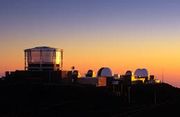
"Close and bright though it is, the Sun still defies a thorough understanding. One reason is that some of the features on its roiling surface are too small and short-lived to be studied even by the world's largest solar telescopes.
That will change if the US National Solar Observatory (NSO) proceeds with its latest project — the Advanced Technology Solar Telescope (ATST), a Sun-gazing behemoth due to be built on the summit of Haleakala, the highest peak on the Hawaiian island of Maui. This month, an officially appointed arbiter will weigh the scientists' goals against objections raised by conservationists and Native Hawaiian groups to decide whether the US$298-million project can break ground later this year." [...]
Heliophysicists say the improved resolution should help solar science to move into the challenging terrain of predicting space weather.
"The societal need is really driving this community," says Thomas Zurbuchen, a solar physicist at the University of Michigan in Ann Arbor, who is vice-chair of a decadal survey for heliophysics that is due to release its research priorities next March. [...]
Ultimately, solar astronomers hope to monitor the Sun 24 hours a day using a global network of telescopes. A European telescope of similar size is planned for the Canary Islands, and India is considering a 2-metre instrument. But the ATST will be built first if it passes a final hurdle.
Comment: The drastic need for new telescopes to monitor the Sun is because Space Weather is now a major issue due to changes in the cosmic environment.
Big jumps in September solar activity metrics
WUWT, 5th October 2011
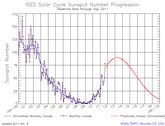
NOAA’s Space weather prediction center released their solar cycle progression updates, and it shows one of the largest jumps for all common solar metrics since cycle 24 began.
Of course we know that the sunspot number has jumped significantly due to the recent large sunspot group that released X-class flares, but there’s more than that.
Comment: In the course of time, we find out that there was a very small group of solar scientists using new and better techniques that predicted a small sunspot cycle, in fact, the smallest in 100 years. Actually, they were wrong, so far it's the smallest sunspot cycle in 200 years. But this is what NASA spokesman David Hathaway was telling the world:
Dec. 21, 2006: Evidence is mounting: the next solar cycle is going to be a big one.
see captionSolar cycle 24, due to peak in 2010 or 2011 "looks like its going to be one of the most intense cycles since record-keeping began almost 400 years ago," says solar physicist David Hathaway of the Marshall Space Flight Center.
Scientists Predict Big Solar Cycle , NASA Science News. 21st December, 2006
As I have said, it does not matter, we only need one massive outburst from the Sun to cripple our modern technological world for millions of people. Here is a sunspot number prediction from 8 years ago
Vukcevic 2004 Sunspot Cycle Prediction. Personally, I am not making any predictions until after the Venus Transit as we need to see if the long term Ap (the solar geomagnetic index) recovers.
Spaceweather.com 5th October 2011
GEOMAGNETIC STORM WATCH: NOAA forecasters estimate a 30% chance of minor geomagnetic storms on Oct. 5th and 6th as a series of two to three CMEs sweeps past our planet. High-latitude sky watchers should be alert for auroras. Storm alerts: text, voice.
FARSIDE CME: Yesterday, October 4th, something exploded on the far side of the sun and propelled a spectacular CME into space. The Solar and Heliospheric Observatory recorded the cloud as it emerged from behind the sun's limb:
Analysts at the Goddard Space Weather Lab have combined observations from SOHO and the twin STEREO spacecraft to calculate the CME's trajectory: It is heading for Mercury. The CME will hit the innermost planet on Oct. 5th around 04:30 UT plus minus 7 hours. Energetic particles accelerated by shock waves at the leading edge of the cloud could also have minor effects on the MESSENGER probe in orbit around Mercury. The CME's forecast track shows that Venus might also receive a blow on Oct. 6th.
Something New On the Sun: SDO Spots a Late Phase in Solar Flares
NASA/SDO News, 7th September 2011
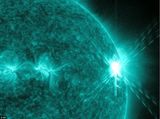
The sun's surface dances. Giant loops of magnetized solar material burst up, twist, and fall back down. Some erupt, shooting radiation flares and particles out into space. Forced to observe this dance from afar, scientists use all the tools at their disposal to look for patterns and connections to discover what causes these great explosions. Mapping these patterns could help scientists predict the onset of space weather that bursts toward Earth from the sun, interfering with communications and Global Positioning System (GPS) signals.
Analysis of 191 solar flares since May 2010 by NASA's Solar Dynamics Observatory (SDO) has recently shown a new piece in the pattern: some 15 percent of the flares have a distinct "late phase flare" some minutes to hours later that has never before been fully observed. This late phase of the flare pumps much more energy out into space than previously realized.
"We're starting to see all sorts of new things," says Phil Chamberlin, deputy project scientist for SDO at NASA's Goddard Space Flight Center in Greenbelt, Md. "We see a large increase in emissions a half-hour to several hours later, that is sometimes even larger than the original, traditional phases of the flare. In one case on November 3, 2010, measuring only the effects of the main flare would mean underestimating the amount of energy shooting into Earth's atmosphere by 70 percent.
Comment: I would call these new observations very surprising.... I thought solar physicists had been intensively watching the sun and monitoring the impact on the ionosphere... Of course, the simple explanation is that this is really something new... and it was not missed because there was previously nothing to miss.... Another example is the 'inky' plasma that is being kicked off during flares, I believe that is something new too, see the latest movie at
spaceweather.com 8th September 2011
Satellite gives better picture of solar flares' effects on Earth
Deliver more energy than was thought: Big implications
The Register, 7th September 2011
CU-Boulder space instrument observes new characteristics of solar flares
Eureka Alert, 7th September 2011
Dark Fireworks on the Sun
NASA Science News, 11th July 2011

July 11, 2011: On June 7, 2011, Earth-orbiting satellites detected a flash of X-rays coming from the western edge of the solar disk. Registering only "M" (for medium) on the Richter scale of solar flares, the blast at first appeared to be a run-of-the-mill eruption--that is, until researchers looked at the movies.
"We'd never seen anything like it," says Alex Young, a solar physicist at the Goddard Space Flight Center. "Half of the sun appeared to be blowing itself to bits." [...]
"IN terms of raw power, this really was just a medium-sized eruption," says Young, "but it had a uniquely dramatic appearance caused by all the inky-dark material. We don't usually see that."
Solar physicist Angelos Vourlidas of the Naval Research Lab in Washington DC calls it a case of "dark fireworks.
Comment: I am sorry to say I saw this headline several times and ignored it because I thought it was too dramatic.... Then I read: "Half of the sun appeared to be blowing itself to bits." Is it any wonder that some people are highly skeptical of NASA media news? The article contradicts itself by stating: "we've never seen anything like it" then it later someone says, "it might be downright common." For the record, I think we can accept the first notion that this was something that scientists have never managed to capture on video. I believe that it was caused by the fact that the sun is processing a different type of energy and since we don't know how the sun works, we could even state we don't even know whether the sun's instructions for how it processes energy from the cosmic environment has changed. Whatever, at the moment, solar scientists are still guessing, but this is important because understanding how the sun works is needed to accurately predict Space Weather.
'Dark Fireworks', unstable magnetic filament explosion, June 7, 2011 event
YouTube, 12th July 2011
Article: Sun's Fading Spots Signal Big Drop in Solar Activity
Space.com, 14th June 2011
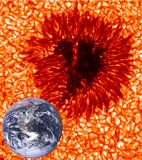
Some unusual solar readings, including fading sunspots and weakening magnetic activity near the poles, could be indications that our sun is preparing to be less active in the coming years.
The results of three separate studies seem to show that even as the current sunspot cycle swells toward the solar maximum, the sun could be heading into a more-dormant period, with activity during the next 11-year sunspot cycle greatly reduced or even eliminated.
The results of the new studies were announced today (June 14) at the annual meeting of the solar physics division of the American Astronomical Society, which is being held this week at New Mexico State University in Las Cruces. [...]
Altrock sifted through 40 years of observations from NSO's 16-inch (40 centimeters) coronagraphic telescope.
New solar activity typically emerges at a latitude of about 70 degrees at the start of the solar cycle, then moves toward the equator. The new magnetic field simultaneously pushes remnants of the past cycle as far as 85 degrees toward the poles. The current cycle, however, is showing some different behavior.
"Cycle 24 started out late and slow and may not be strong enough to create a rush to the poles, indicating we'll see a very weak solar maximum in 2013, if at all," Altrock said.
"If the rush to the poles fails to complete, this creates a tremendous dilemma for the theorists, as it would mean that Cycle 23's magnetic field will not completely disappear from the polar regions. … No one knows what the sun will do in that case."
Comment: For the overall climate on Earth, sunspot activity is important, so this announcement is really a political embarrassment with billions upon billions spent on the gamble of promoting the belief in global warming when low sunspot activity implies global cooling or even an Ice Age. In terms of Space Weather, the Sun could still unleash a massive Coronal Mass Ejection (CME) like it did last week and if it was Earth-directed, there could be some disasterous results due to the
increased transmitting properties of space in our solar system, so low sunspot activity is not a good indicator for space weather effects on Earth.
Major Drop in Solar Activity Predicted
Space Ref News, 14th June 2011
"A missing jet stream, fading spots, and slower activity near the poles say that our Sun is heading for a rest period even as it is acting up for the first time in years, according to scientists at the National Solar Observatory (NSO) and the Air Force Research Laboratory (AFRL)."
Comment: When I wrote my book, I had no idea that a small group of scientists had already worked out that we would experience the lowest sunspot activity in 100 years and in fact they were wrong, instead we experienced the lowest sunspot activity in 200 years. NASA sponsored solar scientists will have red faces whilst these guys are celebrating being right...
BREAKING – major AAS solar announcement: Sun’s Fading Spots Signal Big Drop in Solar Activity
Watts Up With That, 14th June 2011
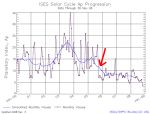
"As I have been saying for some time: The long term Ap (the solar geomagnetic index) has been on a downtrend, ever since there was a step change in October 2005."
Comment: We are waiting for the Venus Transit in 2012, if we see the solar geomagnetic index dramatically change like it did in October 2005, then all bets will be off and it could be hell fire on Earth. Nobody knows for sure and I have not heard anything in the metaphysical community, but quite frankly, I have been not been paying much attention as I can't be bothered to sift through the crap. I expect there to be a lot of more informed discussion at WUWT.
New Insights On How Solar Minimums Affect Earth
NASA JPL News, 14th June 2011
Huge sun explosion rocks astronomers' world
Analysis, research ramped up: 'We're seeing things we've never seen before'
MSNBC News, 9th June 2011
 A huge storm on the sun this week unleashed what some have called the most massive eruption of solar plasma ever seen.
A huge storm on the sun this week unleashed what some have called the most massive eruption of solar plasma ever seen. While that's up for review, the solar storm has revealed a tantalizing glimpse at the inner workings of our nearest star, scientists say.
NASA astronomers said the huge June 7 solar eruption, called a coronal mass ejection, probably wasn't the biggest ever, but it is notable both for its size and its perplexing behavior. Huge waves of plasma roared off the sun only to rain back down on the solar surface.
"We're seeing things we've never seen before," said Phillip Chamberlin, an astrophysicist at NASA's Goddard Spaceflight Center in Greenbelt, Md., and a deputy project scientist on the agency's Solar Dynamics Observatory (SDO) satellite. "It's a really exciting event. There are a lot of exceptions to it." [...]
Another mystery researchers are hoping to solve is why this super-powerful coronal mass ejection was paired with just a moderate solar flare. Experts aren't sure about the connection between the two events, which usually seem to roughly correlate both in timing and strength.
"One of the big questions in solar science is the relationship between solar flares and coronal mass ejections," Chamberlin said. "Can you have one without the other or are they really intimately tied? There are people in the field that will argue both ways."
Comment: The Sun is processing a different type of energy so some of the effects are now recognised as being very different as scientists struggle to be able to predict massive releases of plasma. Solar eruptions create highly disruptive Space Weather that effect our modern technological systems that are highly reliant on satellite communications and technology as well as making our national power grids vulnerable. This solar event is just the latest "surprise" for solar scientists, who acknowledge the sun's recent abberant behaviour that scientists can only suggest is related to unknown long term solar cycles, but it's also likely that the sun is also being affected by an influx of interstellar cosmic dust and energy caused by the arrival of 'G Cloud'.
A new model of the Sun’s open magnetic flux
UCAR, 6th June 2011
"The solar minimum that bottomed out from 2006 to 2010 was the longest and deepest since modern space observations began. Among other effects, it reorganized the areas of flux from open magnetic field lines that produce solar wind. NCAR postdoctoral researcher Liang Zhao is using data from the last two minima to revise a model of how open magnetic flux is transported through the solar atmosphere."
Did A Massive Solar Proton Event Fry The Earth
Space Daily, 6th June 2011
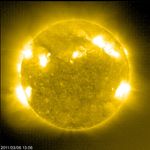
Close to the end of the last ice age there was a sudden disappearance of many mammalian species which some paleontologists say was the most severe since the disappearance of the dinosaurs 65 million years ago. In North America 95 percent of the megafauna became extinct, these being predominantly mammals having body weights greater than 25 to 50 kilograms. But even small animals were affected, as in the disappearance of 10 genera of birds.
Although North America was most affected, it had a severe impact also in Europe, Siberia, and South America. The cause of the extinction has long remained a mystery. Theories that have been put forth have ranged from overkill by North American paleolithic hunters to the impact of a large comet or swarm of meteors. But all have been shown to have serious flaws.
Now, Starburst Foundation researcher Dr. Paul LaViolette has found evidence that this mysterious die-off may have had a solar flare cause. In his paper published this week in the journal Radiocarbon, LaViolette concludes that a super sized solar proton event (SPE) impacted the earth about 12,900 years ago (12,837+/- 10 calendar years BP).*
Comment: Maybe this idea of a super sized solar proton event (SPE), is a new idea, because I can't find the particular details in LaViolette's book
Earth Under Fire. It could also be a refinement to his research that suggests the Sun temporarily became a T Tauri star due to being aggravated by the arrival of interstellar cosmic dust. Whatever, LaViolette needs to be careful, the movie
Knowing (2009) has an apocalyptic ending with a super sized solar flare incinerating the surface of the Earth, so people have been scared. Thus, this theory just adds fuel to the fire, if you can excuse the pun... Well, I have seen some poor efforts by people trying to debunk this film ending, but most people are ignorant of solar science and the history of conflagrations on this planet but this is especially relevant now as our solar system is currently being flooded with interstellar cosmic dust.
Solar Max – So Soon?
Watts Up with That, 8th May 2011
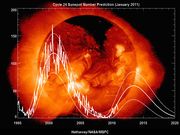
Dr Svalgaard has an interesting annotation on his chart of solar parameters – “Welcome to solar max”: Could it be? It seems that Solar Cycle 24 had only just begun, with solar minimum only two and a half years ago in December 2008. The first place to confirm that is the solar polar magnetic field strength, with data from the Wilcox Solar Observatory:
The magnetic poles of the Sun reverse at solar maximum. The northern field has reversed. There are only three prior reversals in the instrument record. Another parameter that would confirm solar maximum is the heliospheric current sheet tilt angle, also from the WSO site. Theheliospheric current sheet tilt angle has taken a couple of years to reach solar maximum from its current level.
If the Sun is anywhere near solar maximum, the significance of that is that it would be the first time in the record that a short cycle was also a weak cycle...
Comment: Oh my goodness.... I am still looking at this but we are told that the Sun's north pole has reversed but the south has not yet, so that means two south poles but I am not sure that means that we are back to a similar situation that we had back in March 2000 when we had two north poles that lasted for 2/3 months. The reason for the caution is because I have no info on duration which would determine some serious consequences related to the amount of cosmic dust being allowed into the solar system. Then we are being told that the magnetics are suggesting that this is the peak of Solar Cycle 24 which would mean we are experiencing the shortest(?) and weakest on record.... There is a lot of debate here but the concensus is that we don't understand what is going on with the sun. The comments have degenerated into the usual mud slinging between certain characters so I will have to look elsewhere for some expert opinion. Anyway, there is a nice powerpoint presentation below explaining the current status for SC24 estimates.
Update, or Lack Thereof, to the Solar Cycle 24 Prediction - Doug Biesecker (Power Point)
NOAA/SWPC, May 7th 2011
Researchers Crack the Mystery of the Missing Sunspots
NASA Science News, 2nd March 2011
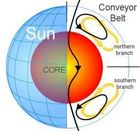
In 2008-2009, sunspots almost completely disappeared for two years. Solar activity dropped to hundred-year lows; Earth's upper atmosphere cooled and collapsed; the sun’s magnetic field weakened, allowing cosmic rays to penetrate the Solar System in record numbers. It was a big event, and solar physicists openly wondered, where have all the sunspots gone?
Now they know. An answer is being published in the March 3rd edition of Nature.
Spotless Sun (conveyor belt, 200px)
In this artistic cutaway view of the sun, the Great Conveyor Belt appears as a set of black loops connecting the stellar surface to the interior.
"Plasma currents deep inside the sun interfered with the formation of sunspots and prolonged solar minimum," says lead author Dibyendu Nandi of the Indian Institute of Science Education and Research in Kolkata. "Our conclusions are based on a new computer model of the sun's interior."
Comment: OK, I am not really impressed with this new retrospective model, it's obvious that sunspots are being suppressed somehow. If they had said they had worked this out five years ago I would have been impressed, this is NOT true science! There is a little sardonic comment over at WUWT by Anthony Watts:
This should be interesting. At least they aren’t putting Dikpati on the panel. The scene from the movie “The Wizard of Oz” where after the residents of Emerald City see strange writings in the sky and shout “the Wizard will explain it!” come to mind.
NASA will try to explain the missing sunspots
LOL! There is plenty more sarcastic comments here plus some interesting new definitions for the acronym NASA....
NASA Reschedules Teleconference To Explain Missing Sunspots
International Business Times, 2nd March 2011
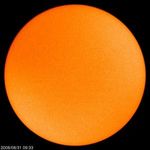
NASA said it has rescheduled a media teleconference to Wednesday 2 pm EST to discuss the first computer model that explains the recent period of decreased solar activity during the sun's 11-year cycle.
The recent solar minimum, a period characterized by a lower frequency of sunspots and solar storms, ended in 2008 and was the deepest one observed in almost 100 years. Solar minimums and maximums are the two extremes of the sun's 11-year activity cycle.
While sunspots were first observed by Chinese astronomers in 800 B.C., systematic observations of sunspots through the telescope started around 1600. In 1843, a German astronomer Samuel Schawbe first discovered that the number of sunspots wax and wane in a cyclic fashion with an 11-year periodicity. This is called the sunspot cycle or the solar cycle.
NASA scientists noted during 2008-2009 that the Sun was undergoing a "deep solar minimum," stating: "There were no sunspots observed on 266 of [2008's] 366 days (73 percent). As of September 14, 2009 there were no sunspots on 206 of the year's 257 days (80 percent),"
NASA's teleconference would focus on the first computer model that explains the recent period of decreased solar activity during the sun's 11-year cycle.
Comment:The issue I have is the fact that some solar scientists predicted low solar activity for solar cycle 24 and they were ignored. Now they have got far more vocal and we are seeing some interesting graphics, see
Dalton Minimum repeat coming? For the source page see
Quote of the week #35 Nat Geo bangs the drum for the next solar cycle. The other thing that bothers me is those scientists who claim that the sun is following the pattern of the 1859 massive Carrington Event, the following comment only hints at this possibility.
May 29, 2009: An international panel of experts led by NOAA and sponsored by NASA has released a new prediction for the next solar cycle. Solar Cycle 24 will peak, they say, in May 2013 with a below-average number of sunspots.
"If our prediction is correct, Solar Cycle 24 will have a peak sunspot number of 90, the lowest of any cycle since 1928 when Solar Cycle 16 peaked at 78," says panel chairman Doug Biesecker of the NOAA Space Weather Prediction Center.
It is tempting to describe such a cycle as "weak" or "mild," but that could give the wrong impression.
"Even a below-average cycle is capable of producing severe space weather," points out Biesecker. "The great geomagnetic storm of 1859, for instance, occurred during a solar cycle of about the same size we’re predicting for 2013."
The 1859 storm--known as the "Carrington Event" after astronomer Richard Carrington who witnessed the instigating solar flare--electrified transmission cables, set fires in telegraph offices, and produced Northern Lights so bright that people could read newspapers by their red and green glow. A recent report by the National Academy of Sciences found that if a similar storm occurred today, it could cause $1 to 2 trillion in damages to society's high-tech infrastructure and require four to ten years for complete recovery. For comparison, Hurricane Katrina caused "only" $80 to 125 billion in damage.
New Solar Cycle Prediction
NASA Science News, 24th February 2011
[MEDIA ADVISORY : M11-043] NASA Reschedules Teleconference To Explain Missing Sunspots
NASA News, 1st March 2011
NASA’s Hathaway revises the sunspot prediction down again
WUWT, 9th February 2011

Current prediction for the next sunspot cycle maximum gives a smoothed sunspot number maximum of about 58 in July of 2013. We are currently two years into Cycle 24 and the predicted size continues to fall.
Additionally, the monthly data plots are out, and there’s been little change from last month in the three major solar indexes plotted by the Space Weather Prediction Center:
Comment: The only thing of interest here is the discussion about the ‘real’ indicator of solar activity. Leif Svalgaard is a respected solar scientists who is still 'adjusting' to the new view of an electromagnetic universe, so some of his exchanges on this and other forums can be quite informative. So we read:
Leif Svalgaard says: February 9, 2011 at 8:50 pm
As we have discussed many times the ‘real’ indicator of solar activity is the the F10.7 microwave flux. The flux is predicted to top ~120 in mid 2013 and seems well on its way to that. The sunspot number is falling progressively below the sunspot number corresponding to the microwave flux. This may be an indication of the Livingston & Penn effect at work. If L&P are correct this discrepancy will grow worse [potentially with no visible spots at all], and the sunspot number will be rather useless as a measure of solar activity, so Hathaway will have to continually adjust the predicted SSN down, down, down. Luckily, the sunspot number is rarely used in operational practice [e.g. for calculation of satellite drag]. Instead, the F10.7 flux is used for that, so as long as we stick to the flux there should be no problems.
First Ever STEREO Images of the Entire Sun
NASA Science News, 6th February 2011
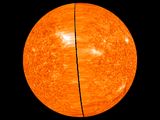
February 6, 2011: It's official: The sun is a sphere.
On Feb. 6th, NASA's twin STEREO probes moved into position on opposite sides of the sun, and they are now beaming back uninterrupted images of the entire star—front and back.
"For the first time ever, we can watch solar activity in its full 3-dimensional glory," says Angelos Vourlidas, a member of the STEREO science team at the Naval Research Lab in Washington, DC.
NASA released a 'first light' 3D movie on, naturally, Super Bowl Sunday:
Comment: A historic moment in solar physics and NASA are celebrating...
NASA | STEREO reveals the Entire Sun
YouTube, 6th February 2011
"Launched in October 2006, STEREO traces the flow of energy and matter from the sun to Earth. It also provides unique and revolutionary views of the sun-Earth system. STEREO, when paired with SDO, can now give us the first complete view of the sun's entire surface and atmosphere."
Sun Pelted by Icy Comet 'Storm'
space.com, 19th January 2011
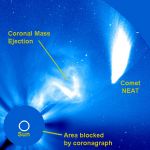
For 10 days in December, a mob of icy comets pelted the sun in an extraordinary cosmic storm. Scientists who monitored the solar tempest now think the flurry of sundiving comets might herald a much bigger comet to come – one that could potentially be visible to the naked eye.
"The storm began on Dec. 13th and ended on the 22nd," Karl Battams of the Naval Research Lab in Washington, D.C., said in a statement. "During that time, the Solar and Heliospheric Observatory (SOHO) detected 25 comets diving into the sun. It was crazy!"
These sundiving comets, known as sungrazers, are not altogether uncommon. In fact, the sun-circling SOHO spacecraft will usually see one plunge into the sun and disintegrate every few days. "But 25 comets in just ten days, that's unprecedented," Battams said.
Comment: Here we have a classic case of amnesia as the author 'forgets' to mention what happened when Comet Neat appeared after only being discovered in November 2002. On February 18th, 2003, the arrival caused a massive blowout on the Sun , which solar scientists immediately claimed was just 'a coincidence', but the Electric Universe theorists totally and utterly refuse to accept this and just added this to the growing list of other coincidences. Interestingly, the recent comet disturbances were also associated with CME's but because of their small size, the CME's were also minor. Anyway, it's official, the space community are expecting the arrival of a monster comet....
Comet Neat and CME's
Thunderbolts.info, May 26, 2005
NASA Sun Spot Number predictions revised again
WUWT, 18th January 2011

The solar cycle 24 predicted sunspot maximum has been reduced again – predicted peak down to 59 Max. (1/3/11) http://solarscience.msfc.nasa.gov/predict.shtml
“It’s tough to make predictions, especially about the future. Philosopher Y. Berra
This will be at the level of the Maunder Minimum of 1675 -1715.
Previous NASA predictions below:
- 2010 October: Predicted peak 60-70
- 2009 May 29: predicted peak: 80-90 range
- 2009 Jan 5: predicted peak: 100-110 range
- 2008 Mar 28: predicted peak: 130-140 range
Comment: Confused with the NASA solar scientists revising solar activity down again? I have linked to WUWT because we have some decent graphics but they don't date back to 2006 when NASA solar scientists were predicting a monster blowout for solar max in 2012. The problem is that it does not matter whether the Sun is generally quiet and lacks sunspots, the Sun has proven that a massive blast can come from nowhere and knock out technological systems. We also have historical data that suggests that this sluggish start could lead to some serious activity and a once in a hundred years (1921/1859) geomagnetic blowout. Then the cosmic environment has changed, as we can conclude after learning that 25 comets hitting the sun in 10 days in December 2010. Yes, that is some serious unprecedented celestial activity to consider when recent observations like when Comet Neat appeared and revealed that the Sun will react to these 'sungrazer' comets. Then there are the Magnetar blasts from deep space that are also hitting the Sun and we have no idea when those are going to occur and how they will effect the Sun. Quite frankly, the commentators here are seriously interested in what is going on with the Sun and their knowleldge and insight is highly valuable, so we read:
Cam (Melbourne, Australia) says: January 18, 2011 at 9:46 pm
I just love how many in the astrophysicist community were predicting a quiet, delayed SC24 5-6 years ago, but of course were never listened to then nor now. They are becoming correct by the day through the process of comparing observational records against their hypotheses, yet the Hansenist NASA among others can move the goalposts monthly and still be the ‘go to’ voice and remain totally unapproachable when it comes to criticism of their failed predictions. [...]
PS. Pardon my ignorance, but what is happening re. the DeVries Cycle – the 208-210yr long-term solar cycle. We’re due for a significant change any year now aren’t we?!
The information I have summarised in the reason why nobody knows for sure what is going on but the risks for our technological society is still too high to ignore. More background info:
Solar Cycle 24 Update
WUWT, February 2, 2010
De Vries Cycle discussion
Massive Coronal Mass Ejection (CME) triggered by comet bombardment?
spaceweather.com, 14th January 2011
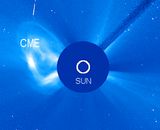
FARSIDE ERUPTION: An active region on the farside of the sun erupted during the early hours of Jan. 13th and hurled a bright coronal mass ejection (CME) into space. Click on the image to play a movie of the expanding cloud recorded by the Solar and Heliospheric Observatory (SOHO):
Although the explosion happened on the sun's farside, one spacecraft had a direct view: STEREO-B is stationed over the sun's eastern limb almost directly above the blast site. The spacecraft's extreme UV telescope recorded the entire event. This movie shows the eruption and the shadowy shock wave it propelled through the sun's atmosphere.
The source of the activity, probably a big sunspot, won't remain on the farside for long. The sun's rotation is turning it toward Earth, and geoeffective solar activity could commence within days. Stay tuned.
Comment: I am now wondering whether this massive CME was provoked by the recent bombardment of comets. I think the shape is quite strange too... More: We can see from the NASA SOHO coronographs (gif animations), there have been
HUGE CMEs in the past few days.
Sundiving Comet Storm - 25 comets in just ten days?
NASA Science News, 12th January 2011
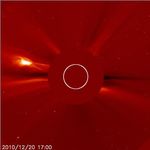 The sun has just experienced a storm—not of explosive flares and hot plasma, but of icy comets.
The sun has just experienced a storm—not of explosive flares and hot plasma, but of icy comets.
"The storm began on Dec 13th and ended on the 22nd," says Karl Battams of the Naval Research Lab in Washington, DC. "During that time, the Solar and Heliospheric Observatory (SOHO) detected 25 comets diving into the sun. It was crazy!"
Sundiving comets—a.k.a. "sungrazers"—are nothing new. SOHO typically sees one every few days, plunging inward and disintegrating as solar heat sublimes its volatile ices.
"But 25 comets in just ten days, that's unprecedented," says Battams.
"The comets were 10-meter class objects, about the size of a room or a house," notes Matthew Knight of the Lowell Observatory in Flagstaff, Arizona. "As comets go, these are considered small."
Comment: We can dismiss the out of date identification of comets as being icy here, because recent observations made of comets up close, have revealed hot dry rocks sometimes covered in tar and others that are demonstrating a plasma sheath (coma) electrically stressed enough to produce x-rays... sigh! Personally, I now prefer to recognise some comets as huge sparks of consciousness delivering celestial messages, based on what Russian scientists have revealed to the world. The universe is an ordered self-organised system that our scientists do not understand very well and we have to recognise that some 'scientific theory' is pure speculation that scientists have agreed amongst themselves to promote. Anyway, these comets might herald a much bigger bombardment of comet bodies from deep space, as it is possible to surmise that the massive magnetar blasts could have been disturbing the Oort cloud that surrounds our solar system (50,000 AU) and beyond.
Longstanding Mystery of Sun's Hot Outer Atmosphere Solved
Science Daily, 7th January 2011

One of the most enduring mysteries in solar physics is why the Sun's outer atmosphere, or corona, is millions of degrees hotter than its surface. Now scientists believe they have discovered a major source of hot gas that replenishes the corona: jets of plasma shooting up from just above the Sun's surface. The finding addresses a fundamental question in astrophysics: how energy is moved from the Sun's interior to create its hot outer atmosphere. [...]
For decades scientists believed spicules could send heat into the corona. However, following observational research in the 1980s, it was found that spicule plasma did not reach coronal temperatures, and so the theory largely fell out of vogue.
"Heating of spicules to millions of degrees has never been directly observed, so their role in coronal heating had been dismissed as unlikely," says Bart De Pontieu, the lead researcher and a solar physicist at LMSAL.
In 2007, De Pontieu, McIntosh, and their colleagues identified a new class of spicules that moved much faster and were shorter-lived than the traditional spicules.
These "Type II" spicules shoot upward at high speeds, often in excess of 100 kilometers per second, before disappearing.
The rapid disappearance of these jets suggested that the plasma they carried might get very hot, but direct observational evidence of this process was missing.
The researchers used new observations from the Atmospheric Imaging Assembly on NASA's recently launched Solar Dynamics Observatory and NASA's Focal Plane Package for the Solar Optical Telescope (SOT) on the Japanese Hinode satellite to test their hypothesis.
"The high spatial and temporal resolution of the newer instruments was crucial in revealing this previously hidden coronal mass supply," says McIntosh.
"Our observations reveal, for the first time, the one-to-one connection between plasma that is heated to millions of degrees and the spicules that insert this plasma into the corona."
The findings provide an observational challenge to the existing theories of coronal heating.
Comment: OK, it's only taken about 75 years from when scientists discovered that the outside (Corona) of the Sun was 300 times hotter than the 6000 K surface and theories of the Electric Sun were first proposed. Since we know that all plasma phenomena is scalable, it's a mystery why these scientists are not telling us that they are comparing the behaviour of these spicules to that seen in plasma research. Don Scott is an ex-Electrical Engineering professor who wrote the book
The Electric Sky. He has an excellent website
The Electric Cosmos that explains that the theory of an Electric Universe. The webpage
'Our sun' is dedicated to explain the behaviour of the Sun based on the properties of plasma in the laboratory. In terms of plasma physics, the "spicules" represent plasma loops or 'double layers' in 'glow' mode that carry a current. When the spicule or loop current becomes too strong, the double layer will be destroyed and that is the source of a solar flare. If you look around the internet, solar flares are supposed to come from the corona and coronal mass ejections are supposed to come from the surface of the Sun called the photosphere but some will tell you that this is not correct either... sigh! This is all very very confusing and if you listen to scientists who are not plasma experts, you will get even more confused. Scott gives credit to Ralph Juergens who developed the Electric Sun model back in the 1970's and nobel prize winner Hannes Alfven's Solar Prominence Circuit. Regardless, this is not just about science for the sake of science anymore. Space Weather in the form of solar flares and coronal mass ejections are causing serious problems for our modern technological society as Earth's magnetic field declines, understanding when to expect a space weather event can at least help to mitigate the damage. More:
New Images From Hinode reveal solar atmospheric plasma behaviors that are 'impossible' to explain according to standard theory.
The Standard Solar Theorist's Slogan: "Anything But Electricity!"
The Surface of the Sun - blog, 3rd April 2007
According to the Harvard-Smithsonian Center for Astrophysics in Cambridge, new images from the Hinode satellite program are already revealing solar atmospheric plasma behaviors that are "impossible" to explain using the current solar model. Evidently the mainstream community is still having a hard time accepting the role of electrical currents in solar activity. They are also having a very difficult time accepting the fact that Hannes Alfv'en actually did know what he was talking about when he described the electromagnetic interactions that take place in *light* (non dense) plasmas. Hannes Alfv'en was the Nobel Prize winning author of magneto hydrodynamic theory. He explained in his book "Cosmic Plasma":
"Again, it should be mentioned that there is no possibility of accounting for the energy of the particles as a result of 'magnetic merging' or of 'magnetic field-line reconnection', or any other mechanism which implies changing magnetic fields in the region of acceleration. In the region of the double layer, the magnetic field during the explosive transient phase is almost constant and cannot supply the required energy (of course, the secondary effects of the explosion also cause changes in the magnetic field)." [...]
Golub may believe that
this sort of plasma behavior is "impossible" to explain, but Hannes Alfv'en
explained this behavior 25 years ago. The atmosphere of the sun is electrically
active and it interacts with the electromagnetic fields of space.
Currents ebb and flow, particularly in the corona. As soon as the electric
currents that are flowing through a coronal loops stop flowing, say for instance
the electric current seeks a shorter path of lesser resistance through the
plasma, the suspended loop will deteriorate rapidly, and it will come crashing
back to the surface. [...]
As Alfven explained from his work in plasma physics, certain types of plasma behaviors simply cannot be be properly modeled or properly understood without considering the electrical flow patterns that are traveling through the plasma. Alfv'en warned the mainstream community during his acceptance speech for the Nobel Prize about trying to mathematically oversimplify every plasma behavior, and trying to model every plasma transaction as a purely "magnetic" event.
Please remember, it is normal in the scientific world for one scientist to be 20, 30, 40, 50+ years ahead of their peers. This becomes apparent by studying the history of many different fields of science.
The sun is still in a slump – still not conforming to NOAA “consensus” forecasts
WUWT, 5th January 2011

"NOAA’s Space Weather Prediction Center (SWPC) produced their monthly solar cycle progression update yesterday. The news is not encouraging. We’ve had a drop in solar activity again in December, The sunspot count is lower, but the really worrisome thing is the Ap geomagnetic index. The solar dynamo has now dropped to magnetic activity levels last seen in late 2009." [...]
It seems to be time again for an update, since it seems likely that the “consensus prediction” has failed. The Livingston and Penn data (from Dr. Leif Svalgaard) continues unabated and on track for sunspots to become invisible when the umbral magnetic field reaches ~1500 gauss.
Livingston and Penn paper: “Sunspots may vanish by 2015?.
But the rest of the world is now just getting around to realizing the significance of the work Livingston and Penn are doing related to sunspots. Science ran with a significant story: Say goodbye to sunspots
Here’s a prominent excerpt:
The last solar minimum should have ended last year, but something peculiar has been happening. Although solar minimums normally last about 16 months, the current one has stretched over 26 months—the longest in a century. One reason, according to a paper submitted to the International Astronomical Union Symposium No. 273, an online colloquium, is that the magnetic field strength of sunspots appears to be waning.
[…]
Scientists studying sunspots for the past 2 decades have concluded that the magnetic field that triggers their formation has been steadily declining. If the current trend continues, by 2016 the sun’s face may become spotless and remain that way for decades—a phenomenon that in the 17th century coincided with a prolonged period of cooling on Earth.
Comment: The recent behaviour of the Sun has historic precedents, where solar activity declined and the Earth cooled resulting in intense cold in Europe. The mosted well known periods were the Maunder Minimum between the 1620s to the 1710s and the Dalton Minimum, between the 1790s and 1820s. The confusing part to predicting solar activity, is that this sluggish behavioour could quickly reverse and turn into a monsterously active Sun, so either way, life is going to change on this planet, there does not seem to be an easy option.
This is worth noting if you watched the AGU meeting (listed below), because the solar scientists did not seem to want to talk about the sun's longer cycles. Russian scientists have discovered a bicentennial cyclic changes in Sun’s luminosity, which they consider to have essential effect on Earth’s climatic changes, see archive
Best of the Blog - The Sun. Yet, even the well know 11 year cycle is only approximate so we read:
"A different solar parameter showing long-term changes is the length of the approximately 11-year sunspot cycle. This quantity is far from being constant. It is known to vary with solar activity so that high activity implies short solar cycles whereas long solar cycles are characteristic for low activity levels of the Sun. Gleissberg (1944) demonstrated that the variation occurred in a systematic manner with a periodicity of 70-90 years similar to, but not exactly in phase with the variation of the magnitude of the sunspot number."
Long-term Variations in Solar Activity and their Apparent Effect on the Earth's Climate
By K.Lassen
Danish Meteorological Institute, Solar-Terrestrial Physics Division,
When trying to understand the probabilities for what could happen on Earth, there is a huge level of omplexity managed by universal intelligence that humans have yet to discover.
Video: Eruptions from the Far-Side: New Global Views of the Sun [47:41]
YouTube, January 2011
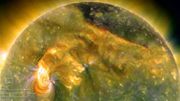 American Geophysical Union (AGU) 2010 Fall Meeting - Press Conference
American Geophysical Union (AGU) 2010 Fall Meeting - Press Conference
New observations of the Sun indicate that the search for the factors that play a role in the initiation and evolution of eruptive and explosive events, sought after for improved space-weather forecasting, requires knowledge of much, if not all, of the solar surface field.
The combination of observations from two NASA missions, the Solar Dynamics Observatory (SDO) and the Solar TErrestrial RElations Observatory (STEREO) enable us to view much of the solar surface and atmosphere simultaneously and continuously for the first time. These near-global observations often show long-distance interactions between magnetic areas that exhibit flares, eruptions, and frequent minor forms of activity. These interactions were previously suspected, but have never been observed until now.
We analyzed a series of flares, filament eruptions, coronal mass ejections, and related events which occurred on 1--2 August 2010. These events extended over a full hemisphere of the Sun, only two-thirds of which is visible from the Earth's perspective.
Comment: This is an exercise: count how many times the solar astrophysicists mentions plasma and magnetics in relation to the Sun. I think we can safely say there has been a paradigm shift. With all the new observations from space probes and satellites sending back data, nobody in any responsible position would now be stupid enough to wax lyrical about the relative merits of gravity to explain the ferocious and explosive plasma manifestations seen on the Sun. I was a little surprised that the experts do not have such distinct definitions for solar flares and coronal mass ejections, but I think the issue is that they are more interested in causality. Well, the Plasma/Elecric Universe pioneers have been partially vindicated, but there are many other cosmic enigmas with their associated outdated theories that need revising too. Interestingly, at around 27 mins, in a reply to a question from the media about the Earth's magnetic field, the answer was to refer to the acceleration of the magnetic North pole and fast changes to the location of the South Atlantic Anomaly (SAA), and hence the quickly changing dynamics within the Earth's core. Again, this all scotches old theory of everything taking millions of years and reminds me of what I wrote in my book, that we know more about the Moon than we do of what is going on beneath our feet. At the end of this press conference, this panel of experts explain the dire state of Space Weather forecasting and in response, the feeling I had was:
God help us...
Global Eruption Rocks the Sun
NASA Science News, 13th December 2010

"Dec. 13, 2010: On August 1, 2010, an entire hemisphere of the sun erupted. Filaments of magnetism snapped and exploded, shock waves raced across the stellar surface, billion-ton clouds of hot gas billowed into space. Astronomers knew they had witnessed something big.
It was so big, it may have shattered old ideas about solar activity."
Comment: So we have a new type of eruption on the Sun, yes that is noteworthy. Here is the YouTube version for the August 1st global eruption [0:12]
Global Eruption Rocks the Sun Apparently, it created a massive CME that did manage to hit Earth too. So, is this back to the drawing board for Space Weather forecasting? Meanwhile, modern societies are reliant on decent Space Weather predictions to prevent avoidable breakdowns of various radio and satellite communications and national power grids etc. For more info:
NASA Images Capture Solar Eruptions Streaking Away at 2.2 Million MPH
Daily Galaxy, 6th August 2010
Coronal Mass Ejections: Scientists Unlock the Secrets of Exploding Plasma Clouds on the Sun
Science Daily News, 14th November 2010
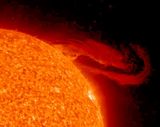
The Sun sporadically expels trillions of tons of million-degree hydrogen gas in explosions called coronal mass ejections (CMEs). Such clouds are enormous in size (spanning millions of miles) and are made up of magnetized plasma gases, so hot that hydrogen atoms are ionized. CMEs are rapidly accelerated by magnetic forces to speeds of hundreds of kilometers per second to upwards of 2,000 kilometers per second in several tens of minutes.
Now, using the data from STEREO, scientists at the Naval Research Laboratory (NRL) in Washington, D.C., have demonstrated for the first time that the observed motion of erupting plasma clouds driven by magnetic forces can be correctly explained by a theoretical model.
The theory, controversial when it was first proposed in 1989 by Dr. James Chen of NRL, is based on the concept that an erupting plasma cloud is a giant "magnetic flux rope," a rope of "twisted" magnetic field lines shaped like a partial donut. Chen and Valbona Kunkel, a doctoral student at George Mason University, have applied this model to the new STEREO data of CMEs and shown that the theoretical solutions agree with the measured trajectories of the ejected clouds within the entire field of view from the Sun to Earth. [...]
Interestingly, the basic forces acting on solar flux ropes are the same as those in laboratory plasma structures such as tokamaks developed to produce controlled fusion energy. The mechanism described by the theory is also potentially applicable to eruptions on other stars.
Comment: Oh well, it's only taken 21 years for technical observations to prove the theory... Anyway, we have a remarkable admission here. It looks like these researchers may have based their theory on laboratory plasma observations which has scaled up to match CME behaviour. Despite the fact that traditional astronomers refuse to consider that we live in a Plasma Universe that is dominated by the electromagnetic force, this theory has passed a major test and should provide alternative thinkers with even more confidence, as we aim to understand how the universe works. I also noted the interesting video associated with the much older article linked to the above, about scientists being able to predict plumes over the United States. In ancient metaphysical language, the plumes have been traditionally referred to as "serpents". See,
Sun Darkens Electronics
Space Physicists and Atmospheric Scientists Can Now Predict Disruptions Caused by the Sun's Coronal Mass Ejections
Science Daily, 1st March 2006
Enormous Ring is Developing on the Sun
Before its News, 16th October 2010
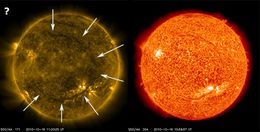
What is this strange ring that has been developing on the Sun during 16-Oct?
Sunspot 1112, located in the southeast quadrant, has been the source of a giant filament that is currently stretching 400,000 km across the surface of the Sun.
However, today, there appears to be development of a enormous circular ring which looks to be linking with the huge magnetic filament of sunspot 1112. Most of today's various wavelength images of the Sun all show this feature over at the SDO (Solar Dynamics Observatory) - NASA website.
SpaceWeather.com today reports,
A vast filament of magnetism is cutting across the Sun's southern hemisphere today. A bright 'hot spot' just north of the filament's midpoint is UV radiation from sunspot 1112. The proximity is no coincidence; the filament appears to be rooted in the sunspot below. If sunspot flares, it could cause the entire structure to erupt. This active region merits watching...
What concerns me is that if indeed this is a huge magnetic filament nearly encircling the entire Sun, it is now currently directly facing the Earth. If sunspot 1112 does erupt, could the entire filament explode into a massive CME?
Comment: OK, this is a few days old now and nothing nefarious has happened, but I still think this event is instructive. The Sun is a huge ball of plasma that clearly demonstrates that the electromagnetic force rules, but at the same time, there are many features that can be explained by understanding that the Sun is also controlled by sound. A huge ring on the sun indicates that it was somehow being "tuned" and we can cite another recent event in the first week of March 2010, when radio heliographic ripples on the Sun produced interesting interference patterns that suggested that the Sun was reacting to gravitational waves from deep space.
NASA’s Hathaway issues new solar cycle prediction
WUWT, 6th October 2010
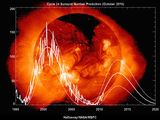
NASA releases their new estimate for SC24. The new number is 64 but not allowing for any 13 month smoothing is noted.
The text is quite comical, they have no idea. By Xmas I predict they will be inline with my prediction made in 2008. Perhaps. This blink comparator that I made (see below), tells the story pretty well.
Back in October of 2007, the SC24 smoothed SSN prediction was for 150. Now it is 64. But, let us not be too critical of Dr. Hathaway, unlike some scientists we know, he has the integrity and courage to admit when his forecasts and models don’t work, and to revise them in the face of reality. Speaking from experience, Nature can be a bitch to forecast.
Comment: It is now very clear that NASA solar scientists don't understand what is happening with our Sun, due to the constant changing of the goalposts with the sunspot prediction no.s for Solar Cycle 24. I have no idea what will happen, but we have other major considerations like the stability of the Earth's magnetic field and solar system shielding to consider, especially as we are getting regular blasts from deep space. G Cloud is now on our solar system doorstep with a strange cosmic feature that looks suspiciously like a huge electric current that is pressing in on the heliosphere. Therefore, making predictions on the future seems rather foolhardy when there are so many factors that our scientists don't understand. Here is the direct link to NASA's press release:
Solar Cycle Prediction (Updated 2010/10/05)
Update
Since, we know that the Sun has many cycles, it seems that claims that the Sun is now operating under different rules dictated by longer term cycles seems highly likely. The issue is: do we know all the different cycle periods and what can we expect? Here is some respected expert opinion at WUWT.
In hindsight on Solar Cycle 24 prediction, what is apparent now could have been predicted a couple of decades ago in that it is a de Vries cycle event. The de Vries cycle is a 210 year cycle. The last one was the Dalton Minimum which started in 1798. The current minimum started right on schedule exactly 210 years after that. In the last 2,000 years, the only time we missed out on a de Vries cycle event was the Medieval Warm Period. So it is about 90% reliable.
Archibald On Dr. Hathaway’s Most Recent Solar Cycle 24 Prediction
Solar Storms can Change Directions, Surprising Forecasters
NASA Science News, 21st September 2010
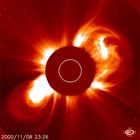
One of the first things they noticed was how CMEs trying to go "up"—out of the plane of the solar system and away from the planets—are turned back down again. Gallagher confesses that they had to "crack the books" and spend some time at the white board to fully understand the phenomenon. In the end, the explanation was simple:
The magnetic field of a bar magnet. The sun's global magnetic field, which is shaped like a bar magnet, guides the wayward CMEs back toward the sun's equator. When the clouds reach low latitudes, they get caught up in the solar wind and head out toward the planets—"like a cork bobbing along a river," says Gallagher. Once a CME is embedded in the solar wind, it can experience significant acceleration.
"This is a result of aerodynamic drag," says Byrne. "If the wind is blowing fast enough, it drags the CME along with it—something we actually observed in the STEREO data." Past studies from other missions had revealed tantalizing hints of this CME-redirection and acceleration process, but STEREO is the first to see it unfold from nearly beginning to end.
Comment: This almost sounds like a boomerang effect, with the Sun's magnetic field steering CMEs... The animation here demonstrates why space weather scientists describe the impact of CMEs on Earth as being like a blanket thrown over a golf ball, a description that was provided in my book
Tuning The Diamonds.
Sun’s magnetics remain in a funk: sunspots may be on their way out
WUWT, 24th September 2010
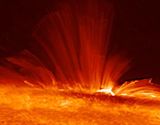
We covered this story about solar magnetic field strength and sunspot contrast months ago on WUWT, and for a couple of years now I have been pointing out that the Ap Interplantary magnetic index took a dive, and has stayed at low levels. [...]
But the rest of the world is now just getting around to realizing the significance of the work Livingston and Penn are doing related to sunspots.
Science just ran with a significant story that is getting lots of press:
Say goodbye to sunspots
Here’s a prominent excerpt:
The last solar minimum should have ended last year, but something peculiar has been happening. Although solar minimums normally last about 16 months, the current one has stretched over 26 months—the longest in a century. One reason, according to a paper submitted to the International Astronomical Union Symposium No. 273, an online colloquium, is that the magnetic field strength of sunspots appears to be waning. [...]
Scientists studying sunspots for the past 2 decades have concluded that the magnetic field that triggers their formation has been steadily declining. If the current trend continues, by 2016 the sun’s face may become spotless and remain that way for decades—a phenomenon that in the 17th century coincided with a prolonged period of cooling on Earth.
Comment: There seems to be a lot of chatter about the behaviour of the Sun but in researching for what is really happening, Anthony Watts & friends are still providing some good solid analysis. So far, Solar Cycle 24 is sluggish and those getting excited by the occasional rash of solar flares and CMEs don't seem to realise that we don't all have to cheer when the Sun occasionally burps. We have seen absolutely nothing compared to what the Sun can do and all the hype about major blasts in 2012/2013 is looking less NOT more likely. In fact, we seem to be sliding into an Ice Age as the Sun's magnetic field is declining rapidly as a few undaunted scientsts have been pointing out with some hard facts for quite some time.
Extended solar minimum linked to changes in Sun’s conveyor belt
UCAR, 12th August 2010
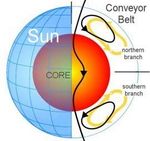
BOULDER—A new analysis of the unusually long solar cycle that ended in 2008 suggests that one reason for the long cycle could be a stretching of the Sun’s conveyor belt, a current of plasma that circulates between the Sun’s equator and its poles. The results should help scientists better understand the factors controlling the timing of solar cycles and could lead to better predictions.
The study was conducted by Mausumi Dikpati, Peter Gilman, and Giuliana de Toma, all scientists in the High Altitude Observatory at the National Center for Atmospheric Research (NCAR), and by Roger Ulrich at the University of California, Los Angeles. It appeared on July 30 in Geophysical Research Letters. The study was funded by the National Science Foundation, NCAR’s sponsor, and by NASA's Living with a Star Program.
The Sun goes through cycles lasting approximately 11 years that include phases with increased magnetic activity, more sunspots, and more solar flares, than phases with less activity. The level of activity on the Sun can affect navigation and communications systems on Earth. Puzzlingly, solar cycle 23, the one that ended in 2008, lasted longer than previous cycles, with a prolonged phase of low activity that scientists had difficulty explaining.
Comment: The Sun's magnetic field which is related to solar activity, usually provides a major defence against cosmic, galactic and intergalactic energy penetrating through to Earth. Earth has three main levels of defence, the heliosphere -- the bubble of magnetism surrounding the Sun, the Earth's magnetic field and Earth's atmosphere, but the first two of this list have been the most important, but they now both declining quickly, see previous comments. Here we see scientists grabbing at straws trying to understand what is happening with our Sun, and trying to explain why forecasts of solar activity have been hopelessly wrong. Regardless, of the scientific theories, Earth is receiving more cosmic, galactic and intergalactic energy that is driving evolutionary change, as can be clearly proven by the current Space Age high in cosmic ray counts. If you look through the News of the Imbalance blog archives, various scientists are seeing cosmic rays having an impact in many different and surprising ways.
COMPLEX ERUPTION ON THE SUN:
Spaceweather.com, 1st August 2010

This morning around 0855 UT, Earth orbiting satellites detected a C3-class solar flare. The origin of the blast was sunspot
1092. At about the same time, an enormous magnetic filament stretching across the sun's northern hemisphere erupted.
NASA's Solar Dynamics Observatory recorded the action:
The timing of these events suggest they are connected, and a review of SDO movies strengthens that conclusion. Despite
the ~400,000 km distance between them, the sunspot and filament seem to erupt together; they are probably connected by
long-range magnetic fields. In this movie (171 Å), a shadowy shock wave (a "solar tsunami") can be seen emerging from
the flare site and rippling across the northern hemisphere into the filament's eruption zone. That may have helped propel the
filament into space.
In short, we have just witnessed a complex global eruption involving almost the entire Earth-facing side of the
sun.
A coronal mass ejection (CME) produced by the event is heading directly for Earth: SOHO movie. High-latitude sky
watchers should be alert for auroras when it arrives on or about August 3rd.
Comment: Well, there are now constant reports of these filament eruptions and maybe they signify that
the Sun is processing a different type of energy associated with the cosmic environment. The question is: are we
witnessing the expected
change of Sun? The C3 flare would have arrived at the speed of light in just over 8 minutes
and consist of X-rays, gamma rays and radio waves which would wash over the Earth and cause some radio
communication problems. The temperature in the region of a solar flare can reach 10 million degrees centigrade and
sometimes this is accompanied by a CME, which occurs when the surface of the Sun just lifts off and blasts into space,
this mass of particles (billions of tons) travels at a much slower speed usually taking 3/4 days to arrive and hit Earth's
magnetosphere.
Now, scientists have these giant filaments to study and instead of a localised region, we have a vast swathe of the Sun
lifting off in one go carrying a complex magnetic field that will have a greater impact on Earth's technological infrastructure,
such as satellites, radio communications, power grids and pipelines. For more details and geomagnetic field forecasts, visit
www.solarcycle24.com/.
There has been a problem at the International Space Agency, but no mention that it was related to the solar flare, but
apparently there was a power Surge (0000 Sunday GMT) see the 3-day solar flux chart
3-day Solar-Geophysical Forecast issued
Aug 02 22:00 UTC . see
Cooling system shut down
aboard space station & space.com
Space Station Suffers Cooling System Malfunction
.
NOAA: behind the curve
Watts Up with That, 16th July 2010
 Comment:
Comment: Obviously, this is a problem for NASA solar scientists who predicted solar max in 2012. From my point of view, it does not matter, as it is clear that the arrival rates of solar, cosmic, galactic and intergalactic energies are still rising, at the same time that Earth's defences in the form of the heliosphere -- the solar system shielding created by the sun -- is flagging.
Earth's magnetic field is sometimes non existent on the daylight side but now has permanent rifts anyway and the atmosphere is not much of a barrier against the onslaught of high energy cosmic rays which are at record highs for the space age. This is a NOAA webpage with their old sunspot predictions
Solar Cycle 24 Prediction Updated May 2009 & shifting goalpost sunspot prediction animation
here This made me laugh, ShrNfr says: July 16, 2010 at 8:27 am
"We could save a lot of money if we hired an octopus."
LOL!!
What's wrong with the sun?
New Scientist, 14th June 2010

SUNSPOTS come and go, but recently they have mostly gone. For centuries, astronomers have recorded when these dark blemishes on the solar surface emerge, only for them to fade away again after a few days, weeks or months. Thanks to their efforts, we know that sunspot numbers ebb and flow in cycles lasting about 11 years.
But for the past two years, the sunspots have mostly been missing. Their absence, the most prolonged for nearly a hundred years, has taken even seasoned sun watchers by surprise. "This is solar behaviour we haven't seen in living memory," says David Hathaway, a physicist at NASA's Marshall Space Flight Center in Huntsville, Alabama.
The sun is under scrutiny as never before thanks to an armada of space telescopes. The results they beam back are portraying our nearest star, and its influence on Earth, in a new light. Sunspots and other clues indicate that the sun's magnetic activity is diminishing, and that the sun may even be shrinking.
Together the results hint that something profound is happening inside the sun. The big question is what?
Comment: Lots to read here. Well, the solar doom has not manifested and NASA scientists can't find out why either. It's a bit of a problem because a huge number of probes have been placed in space to monitor the sun and mitigate space weather which has not happened as predicted, but it seems the real action is now occuring in the form of megablasts from deep space. Apparently, all last week the Earth was ringing like a bell, most likely the Earth being fired on by a magnetar... our scientists cannot hope to provide warnings for this kind of extreme Space Weather.
FANTASTIC PROMINENCE:
Spaceweather, 10th June 2010

A long filament of magnetism circling the sun's north pole is rising into space, producing a truly fantastic prominence. NASA's Solar Dynamics Observatory took this picture just hours ago:
The extreme ultraviolet image shows a cloud of hot (60,000 K) plasma held suspended above the stellar surface by filamentary magnetic forces. The structure is five times taller than Earth and at least 20 times as long. These dimensions make it a fine target for backyard solar telescopes as well as advanced spacecraft.
If the filament becomes unstable and collapses (as magnetic filaments often do), plasma hitting the stellar surface could explode, resulting in a type of flare called a "Hyder flare."
Comment: We seem to have a new trend on the Sun with the continuous ccurence of these huge prominences forming described as a
"Hyder flare", some of which have blown off and come our way as a Coronal mass Ejection (CME). This indicates to me that the Sun is dealing with a slightly different energy input and maybe associated with the dusty plasma that we are now encountering. Elsewhere, more people are getting to hear about Space Weather,
More Active Sun Means Nasty Solar Storms Ahead
Solar Scientists Agree That the Sun's Recent Behavior Is Odd, but the Explanation Remains Elusive
Scientific American, 27th May 2010
 The most recent solar minimum was both long and pronounced. But why?
The most recent solar minimum was both long and pronounced. But why?
MIAMI—In very rough terms, the sun's activity ebbs and flows in an 11-year cycle, with flares, coronal mass ejections and other energetic phenomena peaking at what is called solar maximum and bottoming out at solar minimum. Sunspots, markers of magnetic activity on the sun's surface, provide a visual proxy to mark the cycle's evolution, appearing in droves at maximum and all but disappearing at minimum. But the behavior of our host star is not as predictable as all that—the most recent solar minimum was surprisingly deep and long, finally bottoming out around late 2008 or so.
Comment: Actually, I think that the behaviour of the Sun has been a strange combination of factors that you will not find solar scientists willing to discuss. First, our scientists have no credible theory for the existence of the sun. I understand that the mass of the Sun should haver disappeared a very long time ago if conventional theory is believed. At the moment, I like theory proposed by Stephen Goodfellow who proposes that our sun is a plasma shell around a absolute vacuum, somehow it makes the role of sound waves easier to understand. He believes that solar activity has a role in maintaining the Sun's equilibrium and we know that this is a puzzle for conventional theory, see
An Empty Sun - Is Gravity being Induced?. I think this is an additional refinement to the Sun being an Electric Star because we need an explanation for how the Sun would react if it has to deal with more dusty plasma. We know that the Sun has been crossing over a transition zone that was filled with Birkeland Currents, so we have to presume the historic blasts were how it dealt with the additional matter. Then we had the Venus transit and proof that something seem to "switch off" in the Sun, but if course, that could just be coincidence. Solar activity has increased but it's still not excessive, so it's interesting to see if we have to wait until 2012 for the next Venus passing to see if something gets triggered back "on" again and then if it settles back into something that scientists think is normal.
The Sun's Unchanging Size Baffles Scientists
Space.com, 13th May 2010

The surface of the sun undergoes violent changes on a daily basis, but a group of astronomers has found that the size of our nearest star has been perplexingly constant in recent years.
The new study shows that the sun's diameter has changed by less than one part in a million over the last 12 years. The sun's width today is a steady 932,057 miles (1,500,000 km) across, the researchers found.
"This constancy is baffling, given the violence of the changes we see every day on the sun's surface and the fluctuations that take place over an 11-year solar cycle," Kuhn said.
"The sun is remarkably constant," lead researcher Jeff Kuhn, the associate director of the University of Hawaii Institute for Astronomy, told SPACE.com. "We're measuring that the diameter changes by less than a kilometer (0.62 miles).
Comment: Maybe, we should look elsewhere for answers. Personally, I am impressed with the theory proposed by Stephen Goodfellow who proposes that our sun is a plasma shell around a absolute vacuum. He believes that solar actvity has a role in maintaining the Sun's equilibrium and from the observation being cited here in this article, he could be right.
An Empty Sun - Is Gravity being Induced?
Heliophysics
Thunderbolts.info, 20th April 2010
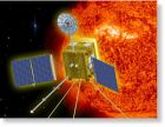
Scientific research into the Sun's composition and behavior has led to a new branch of astrophysics.
The Sun has been the subject of intense research by Electric Universe advocates. Books such as The Electric Sky by retired Professor of Electrical Engineering Don Scott, The Electric Universe by Dave Talbott and Wal Thornhill, and many other independent articles and peer-reviewed papers, have detailed a growing accumulation of data in support of the electrical connection between the Sun and its family of planets, especially Earth.
Over the last several years, NASA and the European Space Agency (ESA), along with the Japan Aerospace Exploration Agency (JAXA), have launched numerous scientific instruments into Earth orbit, as well as other more remote destinations in hope of detecting and analyzing the various ways the Sun's energy influences our planet [...]
The five spinning THEMIS probes contain comprehensive packages of plasma and field instruments needed to determine the cause of geomagnetic substorms. In April of 2009, NASA’s fleet of THEMIS satellites detected vast electrical tornadoes about 40,000 miles above the night side of Earth. Gigantic energized twisters, the size of the earth or larger, channel electrically charged particles at speeds of more than a million miles per hour along the ionosphere's twisted magnetic field, where they power the auroras.
With all of these instruments active at the present time, and 8 more satellites designated as space weather observatories scheduled for launch in the next five years, the opportunities for Electric Universe theories to be supported will continue to increase.
Comment: Lots and lots of probes monitoring the Sun because scientists expected that Space Weather would cause serious trouble in the build up to the peak of solar cycle 24 in 2012. This has not happened, but there are many new factors occuring that need to be properly outlined to provide an adequate explanation. However, one respected metaphysical source was quite clear that we were being given the opportunity to balance up energies on this planet. Anyway, it is becoming apparent that more scientists have shifted their focus away from gravity to understanding the properties of plasma, and how electric fields and currents behave in space. This is reasonable because satellites do not get zapped by gravity.
Magnetic 'ropes' tie down solar eruptions (w/ Video)
PhysOrg.com, 12th April 2010

Using data from the Hinode spacecraft, a team of researchers from University College London (UCL) have revealed an immense magnetic structure that erupted to produce a dramatic solar eruption in late 2007. Solar scientist Dr Lucie Green will present their results at the RAS National Astronomy Meeting in Glasgow on Monday 12th April. [...]
Dr. Green says,
“Magnetic flux ropes have been observed in interplanetary space for many years now and they are widely invoked in theoretical descriptions of how CMEs are produced.We now need observations to confirm or reject the existence of flux ropes in the solar atmosphere before an eruption takes place to see whether our theories are correct.”
Comment: So, this article is about magnetic flux ropes on the surface of the Sun which is just a huge ball of plasma, but actually does not mention the standard behaviour of plasma where a flow of charged particles in a plasma (an electric current) has a tendency to form filaments that braid themselves into a rope and thus create it's own magnetic field. Typical really....Anyway, there have been instances where highly impressive giant ropes have been seen sticking out of the sun before ejecting or collapsing. The image icon used here is The Bastille Day Slinky, from July 14, 2000. It covered an area of 186,000 miles across, which is large enough to span 23 Earths at a temperature of 2.7 million degrees Centigrade. See an enlarged version
here.
Spaceweather.com - 13th April 2010
Huge prominence blast off with a good sized filament, see
Image 1,
Image 2 &
Image 3, the sun looks like it's getting back on form...
OMG! MONSTER PROMINENCE:
Solar 'Current of Fire' Speeds Up
NASA News, 12th March 2010

In today's issue of Science, NASA solar physicist David Hathaway reports that the top of the sun's Great Conveyor Belt has been running at record-high speeds for the past five years.
"I believe this could explain the unusually deep solar minimum we've been experiencing," says Hathaway.
"The high speed of the conveyor belt challenges existing models of the solar cycle and it has forced us back to the drawing board for new ideas."
The Great Conveyor Belt is a massive circulating current of fire (hot plasma) within the sun. It has two branches, north and south, each taking about 40 years to complete one circuit. Researchers believe the turning of the belt controls the sunspot cycle.
Comment: I saw this at WUWT a few days ago where most commentators were less than impressed with Hathaway's obvious non-science of banging a theory around observations which of course have now changed and so the theory has just crocked. See
Hathaway on the solar conveyor belt and deep solar minimum.
So now that NASA are happy to tell us that they don't have a clue, we can listen to those with interesting alternative ideas. Here is Stephen Goodfellow with his ideas on our sun being a plasma shell around a absolute vacuum.
An Empty Sun - Is Gravity being Induced?
I am not sure he is completely right but some of the ideas are worth considering, especially about the role of solar actvity in maintaining the Sun's equilibrium. This is all very interesting as the Sun's activity was at historic levels in the last solar cycle and solar minumum was long and drawn out, so others have made a direct link to the changing plasma environment of our solar system which would fit this theory. Well, I am getting to the stage of total disbelief about the what is happening, but thankfully I don't feel so on my own as others are also putting the Big Picture together with the science, but don't realise or know the metaphysical implications. Some of the speculation circulating now is based on informed opinion and those in the know realise we are certainly in for some "interesting times ahead".
Rare 'solar corona' caught on camera
The elusive 'solar corona' - a plasma gas atmosphere around the sun where temperatures reach two million degrees - visible only during a total eclipse, has been captured on camera.
The Telegraph, 10th March 2010
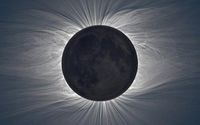
The pictures were taken during an eclipse over the isolated Marshall Islands, near Papua New Guinea in the Pacific Ocean. Ten times as dense as the centre of the sun, the corona only produces about one-millionth as much light - meaning that it can only be seen when 'lit up' during an eclipse.
Click here to see a high-resolution version of the image
The main radiation from the sun's surface during a total solar eclipse is blocked by the passage of the moon enabling rare viewings of the corona. Organised by the Brno University of Technology in the Czech Republic, the shadow-tracking expedition took these remarkable pictures to study changes in the plasma. [...]
The mysterious corona has puzzled scientists for years - it extends more than a million kilometres from the sun yet is over 200 times hotter than the sun's visible surface. The source of the corona's heat is still the subject of debate, but is likely to include the Sun's magnetic field and sonic pressure waves from below the sun.
Comment: Wow! I am a little stunned, as this photo by Czech scientists is incredible and reveals more about how the Sun works. I note this article states that solar scientists have moved on and does NOT explain the temperature inversion on the surface of the Sun at 6000K with the corona around the sun at 2 million K, on the outdated fusion model. Good!
Radio Heliographic ripples on the Sun extensive the past two days!
Large quake may loom in the next 48 hours!
GLP Board, 8th March 2010
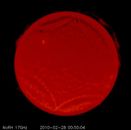

I was curious about the last two quakes and wave patterns on the Nobeyama Radioheliograph 10min Movies of the sun. There seemed to be a correlation so I will post the information here for this objective thought. What you will look for is wave pattern (ripples) moving across the sun on the movies and the time at the bottom. It seem’s these happen within a 24 hour period of the quakes listed below. From 08-01-2008 to 03-01-2010 there were 60 of these in 20 months, which averages 3 per month. Links to movies under the earthquake.
Comment: Someone at GLP has noticed that the Sun is getting hit and we can see some interesting interference patterns that remind me of a few crop circles. I think we are seeing interference patterns caused by gravitational waves. The Asian tsunami in December 2004 was enough to convince some astronomers that Magnetar blasts can generate gravitational waves and we know that this activity has been seriously stepping up in gears hence the severe Space Weather. Sigh! Ignore the Mayan stuff and look at the scientific info on gravitational waves,
"The crop picture which appeared on August 18, 2006 at Etchilhampton Hill seems to show (i) the four-fold pointed-symmetry of a gravitational wave field, as well as (ii) certain grid lines which are commonly used to represent gravity or curved space time ." Source:
here
At least we were warned in advance!
Warning: the GLP forum is rough!
Our Misunderstood Sun
Holoscience.com, 1st March 2010

-
“We stand on the verge of a vast cosmical discovery such as nothing hitherto imagined can compare with.”
—William Herschel in 1850, upon the discovery of a link between magnetic storms on Earth and sunspots, to Michael Faraday, the vaunted experimentalist who was investigating the links between electricity and magnetism.
Incredibly, one hundred and sixty years later in the space age, Herschel’s “vast cosmical discovery such as nothing hitherto imagined can compare with,” of an Electric Universe, remains “on the verge.” Mistaken ideas have diverted scientists down the path of Ptolemy once more, adding endless epicycles to theory to save appearances. Meanwhile the object central to the problem is the same and in full view. It is our misunderstood Sun.
Comment: Excellent! I am very pleased to hear that Wal Thornhill is receiving a reward for his work on the Electric Universe. I don't agree with everything and particularly the fact that Electric Universe theorists do not believe in higher dimensions, but quite frankly, once you start to grasp the basic idea, cosmology is simplier and some metaphysical symbols and concepts become much less enigmatic, as we are given new insights into the workings of the universe.
The great filament
WUWT, 24th February 2010
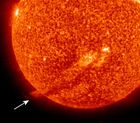
The Solar and Heliospheric Observatory (SOHO) is tracking an enormous magnetic filament on the sun. It stretches more than one million kilometers from end to end, which makes it an easy target for backyard solar telescopes. For the seventh day in a row, an enormous magnetic filament is hanging suspended above the surface of the sun’s southern hemisphere. The Solar and Heliospheric Observatory (SOHO) has a great view. How long can it last? Solar filaments are unpredictable. If this one collapses and hits the stellar surface, the impact could produce a powerful Hyder flare.
Comment: This is basically a synopsis of what's been going on with the sun and a tutorial on Hyder flares. The 'Great Magnetic Filament' errupted on between 0719 and 1919 UT on Feb. 24th. see,
OH, SNAP!
which generated a CME see
movie and we are told: "If any of this material is heading for Earth--a big unknown!--it should arrive on Feb. 27th or 28th. Arctic sky watchers should be alert for auroras on those dates." So, we have a huge number of space probes watching the Sun but they can't tell us if a CME is coming our way, just not very good. Btw, NASA made an announcement
NASA Unveils New Space-Weather Science Tool, I can't say I am really excited about it.
Mystery: UFO Spotted Flying Across Sun
The Sun, 1st February 2010
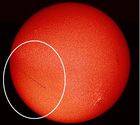 A BRITISH stargazer has taken an amazing video of a UFO crossing the face of the sun
A BRITISH stargazer has taken an amazing video of a UFO crossing the face of the sun
Malcolm Park was taking a series of photos of the huge star through a specially filtered telescope when a strange object began to drift across it.
Malcolm, of South West London, said: "I was recording activity on the sun when I caught this strange encounter. It looks like an irregularly-shaped lump of rock and is clearly rotating very quickly.
Comment: Well, if you spend a lot of time on conspiracy forums you will know that there has been a lot of excitement in the last week, but I decided to wait and see what happens. Now, the mainstream has decided to report various strange objects in space. The video clip [0:28] here is quite nice. Please note: the spheres that have been seen in the Sun's corona, do not display the characteristics described here. At the moment, I have decided to refrain from speculation until the facts become clearer as to what is happening.
WIDE SUNSPOT:
News, 13th January 2010

Sunspot 1040 has grown so large (ten times wider than Earth) that only a fraction of it fits on the page. Click on the image for the big picture:
here
Dennis Simmons sends the image from Brisbane, Australia, where a short spell of exceptionally steady air this morning allowed him to capture the sunspot with superb clarity.
"After the software had processed my data, I was left gasping, astonished by what the seeing had allowed me to witness. This is far and away my best-ever high-resolution image of a sunspot."
Comment: Hmmm.... The image icon used here is from the 22nd December 2009. The sun has been spitting solar flares and corona mass ejections and according to some, this was all caused by a sungrazer comet. Now of cause, in the gravity driven universe this is complete nonsense and just a coincidence but this just ignores all the facts that scientists now know due to their high tech space probes that are providing them with lots of embarrasing contradictions to accepted theory. So in the real universe dominated by electromagnetism, comets are an electrical phenomena and they admit a wide range of frequencies including x-rays and radio signals. Yes, that's right, comets are in constant communication with the universe and so is the Sun. At the moment, the belief by some is that the comet discovered by amateur astronomer Alan Watson distingrated, but it's mission was to trigger the sun from an extemely deep solar minimum. There has been quite a lot of action in the last week or so, but the sun had apparently woken up anyway, but in this solar minimum, these awakenings have been followed by deep slumber again, so the following timeline is of interest because we have some real action now:
-
Spaceweather.com,
22 Dec 2009
SOLAR ACTIVITY: The sun is showing signs of life. There are no fewer than five active regions on the sun's surface, shown here in an extreme ultraviolet photo taken this morning by the Solar and Heliospheric Observatory (SOHO):
-
Spaceweather.com,
23 Dec 2009
SOLAR ACTIVITY: Yesterday, Dec. 22nd at approximately 0455 UT, magnetic fields around sunspot 1036 erupted, producing a C7-class solar flare. NASA's STEREO-A spacecraft was almost directly above the sunspot at the time of the blast and recorded this extreme ultraviolet movie:
-
Spaceweather.com,
27 Dec 2009
SOLAR ACTIVITY INTENSIFIES: 2009 is ending with a flurry of sunspots. The latest is sunspot 1039, which formed yesterday and is now crackling with low-level solar flares. Cai-Uso Wohler sends this picture of a B-class eruption from his backyard observatory in Bispingen, Germany:
-
Spaceweather.com,
2 Jan 2010
SUNGRAZING COMET ALERT: The Solar and Heliospheric Observatory (SOHO) is tracking a comet that is about to make a perilous close approach to the sun:
-
Spaceweather.com,
3 Jan 2010
DISINTEGRATING COMET: A bright comet discovered by NASA's STEREO-A spacecraft is swinging by the sun today and apparently disintegrating. Click on the image to set the scene in motion:
-
Spaceweather.com,
4 Jan 2010
COMET TOAST: The solar system has one less comet. The subtraction occurred yesterday when a bright comet discovered by NASA's STEREO-A spacecraft plunged toward the sun and evaporated. The Solar and Heliospheric Observatory (SOHO) had an excellent view of the encounter.
-
Spaceweather.com,
5 Jan 2010
EASY COME, EASY GO: Sunspot 1039 is about to disappear over the sun's western limb, but the sun won't remain blank for long. Another active region is approaching from the east, shown here in a Jan. 5th image from the Solar and Heliospheric Observatory:
-
Spaceweather.com,
6 Jan 2010
SOLAR ACTIVITY: Yesterday, January 5th, something exploded on the back side of the sun and hurled a coronal mass ejection (CME) into space. Click on the SOHO image to see the billion-ton cloud in motion:
-
Spaceweather.com,
7 Jan 2010
SUNSPOT CORPSE: After a two-week trip around the farside of the sun, sunspot 1035 has returned, but it not a sunspot anymore. Where there was once a dark-cored behemoth crackling with solar flares, there is now just a quiet splash of magnetic froth. Call it a "sunspot corpse":
-
Spaceweather.com,
8 Jan 2010
SUNSPOT RESURRECTED: Old and decaying sunspot 1035, declared to be "a corpse" just yesterday, is showing signs of renewed life. Pete Lawrence sends this picture from his backyard observatory in Selsey, UK:
-
Spaceweather.com,
9 Jan 2010
SOLAR ACTIVITY: Today has brought an uptick in solar activity. Sunspot 1040 (a.k.a. old sunspot 1035) is crackling with minor solar flares and seems to be gathering itself for something more. Just hours ago, the Solar and Heliospheric Observatory captured this C1-class eruption:
-
Spaceweather.com,
10 Jan 2010
BIG SUNSPOT: Sunspot 1040 (a.k.a. old sunspot 1035) is growing again and is now at least four times wider than planet Earth. A blink comparison of SOHO images shows how the sunspot has expanded in the past 24 hours:
-
Spaceweather.com,
11 Jan 2010
BIG SUNSPOT: Sunspot 1040 is busy growing again. In only 24 hours, it has expanded from a barely visible "sun-speck" to a planet-sized active region with 15 dark cores and a tangled magnetic field.
SOLAR ACTIVITY: The sun is showing signs of life.
Space Weather.com, 22nd December 2009

SOLAR ACTIVITY: The sun is showing signs of life. There are no fewer than five active regions on the sun's surface, shown here in an extreme ultraviolet photo taken this morning by the Solar and Heliospheric Observatory (SOHO):
Each circle contains a sunspot or proto-sunspot belonging to new Solar Cycle 24. After two years of record-low sunspot numbers and many month-long stretches of utter quiet, this is a notable outbreak. Whether it heralds a genuine trend or merely marks a temporary, statistical uptick in activity remains to be seen. Stay tuned!
Comment: I think this must be a cause for celebration, there have been some very worried solar scientists in the last 18 months or so.
INCOMING CME & BIG NEW SUNSPOT
Spaceweather.com, 16th December 2009
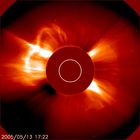
This morning at 0120 UT, an eruption of magnetic fields around sunspot 1035 produced a long-duration C4-class solar flare and hurled a coronal mass ejection (CME) in the general direction of Earth. High-latitude sky watchers should prepare for auroras when the CME arrives on or about Dec. 18th. Movies: solar flare, CME.
New sunspot 1035 is growing rapidly and it is now seven times wider than Earth. This makes it an easy target for backyard solar telescopes. Yesterday, Rogerio Marcon of Campinas, Brazil, photographed a maelstrom of hot plasma and magnetic filaments connecting the sunspot's dark cores:
"Solar activity is picking up," he says.
The magnetic polarity of the spot identifies it as a member of Solar Cycle 24--the cycle we've been waiting for to end the deepest solar minimum in nearly a century. One spot isn't enough to end the lull, but sunspot 1035 could herald bigger things to come. Stay tuned for updates.
Comment: Here we have some action on the Sun. I have updated my
Joyfire SpaceWeather Explorer (but it's not finished yet) and there is a new
Extreme Space Weather section.
More to Solar Cycle than Sunspots; Sun Also Bombards Earth with High-Speed Streams of Wind
UCAR, 17th September 2009
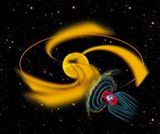 "Challenging conventional wisdom, new research finds that the number of sunspots provides an incomplete measure of changes in the Sun's impact on Earth over the course of the 11-year solar cycle.
"Challenging conventional wisdom, new research finds that the number of sunspots provides an incomplete measure of changes in the Sun's impact on Earth over the course of the 11-year solar cycle. The study, led by scientists at the High Altitude Observatory of the National Center for Atmospheric Research (NCAR) and the University of Michigan, finds that Earth was bombarded last year with high levels of solar energy at a time when the Sun was in an unusually quiet phase and sunspots had virtually disappeared.
"The Sun continues to surprise us," says NCAR scientist Sarah Gibson, the lead author. "The solar wind can hit Earth like a fire hose even when there are virtually no sunspots." [...]
Scientists previously thought that the streams largely disappeared as the solar cycle approached minimum. But when the study team compared measurements within the current solar minimum interval, taken in 2008, with measurements of the last solar minimum in 1996, they found that Earth in 2008 was continuing to resonate with the effects of the streams.
Although the current solar minimum has fewer sunspots than any minimum in 75 years, the Sun's effect on Earth's outer radiation belt, as measured by electron fluxes, was more than three times greater last year than in 1996.
[...]
The prevalence of high-speed streams during this solar minimum appears to be related to the current structure of the Sun. As sunspots became less common over the last few years, large coronal holes lingered in the surface of the Sun near its equator. The high-speed streams that blow out of those holes engulfed Earth during 55 percent of the study period in 2008, compared to 31 percent of the study period in 1996. A single stream of charged particles can last for as long as 7 to 10 days.
At their peak, the accumulated impact of the streams during one year can inject as much energy into Earth's environment as massive eruptions from the Sun's surface can during a year at the peak of a solar cycle, says co-author Janet Kozyra of the University of Michigan. [...]
"The Sun-Earth interaction is complex, and we haven't yet discovered all the consequences for the Earth's environment of the unusual solar winds this cycle," Kozyra says.
"The intensity of magnetic activity at Earth in this extremely quiet solar minimum surprised us all. The new observations from last year are changing our understanding of how solar quiet intervals affect the Earth and how and why this might change from cycle to cycle."
Comment: Basically, these scientists are telling us that the concept of a solar minimum is misleading and especially in this current solar minimum, the sun's magnetic configuration has meant that we have been blasted hard. Metaphysical sources who predicted that the saturation of our planet with subtle energies will dramatically increase from 2007, may now have some scientific backing. Now, for any who still doubt the reason for why 'risky' experiments are taking place in our atmosphere, I would recommend a serious study of Space Weather and what has been going on for the last 20+ years, it is certain that you will discover that the New Cosmic Age has arrived!
Update:
Dr Leif Svalgaard has objected to this article and states:
"IMHO this is just another PR stunt, ‘never seen before’, ‘overturns what we thought before’, etc. ... It is amazing that each new generation of scientists will have to rediscover and relearn what was already known. But such is human nature, every generation has to do this."
This is something that I have noted time and time again with the scientific community and it makes it very difficult to assess what is going on when scientists provide an incomplete picture to suit their own ends. For more information, click link for
Watts Ups With That, one of the best science blogs on the internet,
NCAR: “number of sunspots provides an incomplete measure of changes in the Sun’s impact on Earth”
Solar wind surprise: “This discovery is like finding it got hotter when the sun went down,”
Watts Up with That, 10th September 2009
 "This gives a whole new meaning to “Total Solar Irradiance”. Instead of TSI, perhaps we should call the energy transfer that comes from the sun to the earth TSE for “Total Solar Energy” so that it includes the solar wind, the geomagnetics, and other yet undiscovered linkages.
"This gives a whole new meaning to “Total Solar Irradiance”. Instead of TSI, perhaps we should call the energy transfer that comes from the sun to the earth TSE for “Total Solar Energy” so that it includes the solar wind, the geomagnetics, and other yet undiscovered linkages. [...]
The sun, in addition to emitting radiation, emits a stream of ionized particles called the solar wind that affects the Earth and other planets in the solar system. The solar wind, which carries the particles from the sun’s magnetic field, known as the interplanetary magnetic field, takes about three or four days to reach the Earth. When the charged electrical particles approach the Earth, they carve out a highly magnetized region — the magnetosphere — which surrounds and protects the Earth.
Charged particles carry currents, which cause significant modifications in the Earth’s magnetosphere. [...]
“Any space physicist, including me, would have said a year ago there could not be substorms when the interplanetary magnetic field was staying northward, but that’s wrong,” Lyons said. “Generally, it’s correct, but when you have a fluctuating interplanetary magnetic field, you can have substorms going off once per hour. [...]
“The energy of the particles and the fields in the magnetosphere can vary by large amounts. It can be 10 times higher or 10 times lower from day to day, even from half-hour to half-hour. These are huge variations in particle intensities, magnetic field strength and electric field strength,” Lyons said. [...]
In our field,
this finding is pretty earth-shaking. It’s an entire new mode of energy transfer, which is step one. The next step is to understand how it works. It must be a completely different process.”
Comment: From the comments on this blog the best summary comes from Jim (10:13:03) : "Hmmm… They knew about DC solar current, but just discovered AC. Now the picture looks more complete. Now on to capacitors and inductors."
I am sure there will be comprehensive comment from Electric Universe theorists, but "a stream of ionised particles" is an electric current. When it's fluctuating backwards and forwards, it generates an alternating current that will heat things up. However, the concept of electricity in space has only been considered by a few hardy pioneers, but due to Space Weather causing all sorts of problems, scientists are being forced to re-evaluate and the evidence is overwhelming as we discover brand new electromagnetic mechanisms for how our planet is linked to the wider cosmic environment. There is some mention on the blog about a massive Gamma Ray Burst (GRB) event 21st January 2009 that caused a Sudden Stratospheric Warming, where parts of the stratosphere heated up by 40 degrees! Is it any wonder that those in the know are just now extremely cynical about the supposed effects of CO2. See also,
Atmospheric Solar Heat Amplifier Discovered
ROCKETING PLASMA BLOB
Spaceweather.com, 7th September 2009
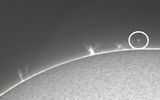
"Solar activity is low, but it's not zero. Consider the following: On Sept. 5th, Jean-Paul Godard of Paris, France, was watching some prominences gently wave over the edge of the sun when, suddenly, a plasma blob rocketed into view:
"I've never seen a fast ejection like this before," says Godard. "I recorded the action using a 3-inch refracting telescope and a Coronado SolarMax filter."
The blob does not appear to have escaped the sun. Indeed, it might not have been a blob at all, but rather a plasma wave traveling up a magnetic flux tube--and 'breaking' when it reached the top. Whether it was a rocketing blob or breaking wave, it shows that even the quiet sun is worth watching
Comment: The video clip shows a 'blob' of plasma breaking away from the Sun, but the discussion about whether it escaped is puzzling. Regardless, the sun watcher states he has never seen a fast ejection before and maybe he was just lucky, Russian scientists tell us that plasma entities arrive on Earth via the sun and their frequency increases in years of active Sun. Maybe this was more than just a 'blob'.
SOLAR MINIMUM VS. GLOBAL WARMING:
spaceweather.com, 4th September 2009

"From 2002 to 2008, decreasing solar irradiance has countered much anthropogenic warming of Earth's surface. That's the conclusion of researchers Judith Lean (NRL) and David Rind (NASA/GISS), who have just published a new analysis of global temperatures in the Geophysical Research Letters. Lean and Rind considered four drivers of climate change: solar activity, volcanic eruptions, ENSO (El Nino), and the accumulation of greenhouse gases. [...]
Volcanic aerosols are a source of cooling; ENSO and greenhouse gases cause heating; the solar cycle can go either way. When added together, these factors can account for 76% of the variance in Earth's surface temperature over the past ~30 years, according to the analysis of Lean and Rind.
Several aspects of their model attract attention: "The warmest year on record, 1998, coincides with the 'super-El Nino' of 1997-98," points out Lean. "The ESNO is capable of producing significant spikes in the temperature record." Solar minimum has the opposite effect:
"A 0.1% decrease in the sun's irradiance has counteracted some of the warming action of greenhouse gases from 2002 - 2008," she notes. "This is the reason for the well-known 'flat' temperature trend of recent years."
Comment: Most people call this kind of analysis hindsight. It was certainly not expected from the many different climate model predictions.
Are Sunspots Disappearing?
NASA News, 3rd September 2009
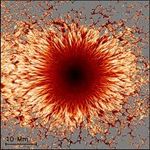
"The sun is in the pits of the deepest solar minimum in nearly a century. Weeks and sometimes whole months go by without even a single tiny sunspot. The quiet has dragged out for more than two years, prompting some observers to wonder, are sunspots disappearing?
"Personally, I'm betting that sunspots are coming back," says researcher Matt Penn of the National Solar Observatory (NSO) in Tucson, Arizona. But, he allows, "there is some evidence that they won't." Penn's colleague Bill Livingston of the NSO has been measuring the magnetic fields of sunspots for the past 17 years, and he has found a remarkable trend. Sunspot magnetism is on the decline: [...]
"Whether [the current downturn] is an omen of long-term sunspot decline, analogous to the Maunder Minimum, remains to be seen," Livingston and Penn caution in a recent issue of EOS. "Other indications of solar activity suggest that sunspots must return in earnest within the next year."
Whatever happens, notes Hathaway, "the sun is behaving in an interesting way and I believe we're about to learn something new."
Comment: OK, it's official, even NASA are worried. The issue is that no sunspots means very low solar activity, so the Sun will not be able to deflect as many cosmic rays. Ultimately, this means Earth will lose more of it defense against cosmic, galactic and intergalactic energies. Due to the fine balance of solar activity, relatively high activity or low activity, either way just means Earth will be exposed to a different type of Space Weather, as Earth's magnetic field continues to decline and periodically 'cracks' appear in the magnetosphere. Thus, the Mayan prophecy of a New Age dominated by space or the ether is looking more definite and long term as time progresses.
Tiny Flares Responsible for Outsized Heat of Sun's Atmosphere
NASA News, 14th August 2009
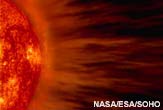
"The mystery of why temperatures in the solar corona, the sun's outer atmosphere, soar to several million degrees Kelvin (K) —much hotter than temperatures nearer the sun's surface—has puzzled scientists for decades. New observations made with instruments aboard Japan's Hinode satellite reveal the culprit to be nanoflares. [...]
Nanoflares are responsible for changes in the X-ray and ultraviolet (UV) radiation that happen as an active region evolves. X-ray and UV get absorbed by Earth's upper atmosphere, which heats up and expands. Changes in the upper atmosphere can affect the orbits of satellites and space debris by slowing them down, an effect known as "drag." It is important to know the changing orbits so that maneuvers can be made to avoid space collisions. The X-ray and UV also affect the propagation of radio signals and thereby adversely affect communication and navigation systems.
The discovery that nanoflares play an important and perhaps dominant role in coronal heating paves the way to understanding how the sun affects Earth, our place in the universe."
Comment: Well, after 70 years of finding out that the surface of the Sun is 6000 Kelvin, but the Corona (meaning crown) is about 2 million Kelvin and that solar flares can generate heat in the region of 10 million Kelvin, astronomers are now talking plasma physics. As the article explains, Space Weather is seriously focusing the best minds to understand how we can operate technology in the new extreme space environment around Earth. Since the Sun is a huge ball of plasma, in a visible universe that is 99.999% plasma, it' is still quite difficult to comprehend why processes that were duplicated in the laboratory by plasma physicists decades ago have only become acceptable now. Please note, this and similar press releases means the Thermonuclear (Fusion Model) of how the Sun produces heat is now dead. This means that scientists are no longer bound by old ideas that have always been challenged by copious amounts of observational data that were just conveniently ignored.
Some speculation that solar cycle 25 has already begun
Watts Up With That, 1st August 2009

Some speculation that solar cycle 25 has already begun:
.pdf This would be stunning, because it suggests that the sun has skipped a solar cycle (#24). Researchers, three from the Harvard-Smithsonian Center for Astrophysics and the other from Marshall Space Flight Center-NASA, have published a paper that suggests this possibility.
Does a polar coronal hole’s flux emergence follow a Hale-like law?"
Comment: Since solar cycles are a specialist subject, it's worth reading the comments from people who are extremely interested in the no. 1 life sustainer in our solar system. As Nasif Nahle (13:23:02) : states "The Sun did not skip a cycle, but a cycle from a modeling prediction was missed. Nature is the reality; models are our suppositions on what the next step of nature could be. The Sun is behaving as always, but this cycle has been different from other observed cycles; to be precise, the Sun is working normally. The main difficulty is that astrophysicists and solar physicists do not count on reliable data for periods before the advent of satellite measurements. Perhaps the observation of other stars would help us to understand the mechanics of our own star because we are capturing cosmic events that happened in the past, as if the stars, galaxies, and other celestial bodies were cosmic fossils; unfortunatelly, we have not yet the capability of registering such changes in stars because we only perceive them as dots, even with high resolution telescopes." I believe that Nasif Nahle is trying to convey that our scientists do not have enough data to accurately predict the behaviour of the Sun. This is the same reason why Space Weather scientists admit to using Mayan Calendars, astrology and ancient text for trying to enhance their understanding of the Sun's behaviour. If we have indeed skipped a cycle, then it might help us understand the Mayan concept of a 'change of Sun'.
RESURGENT SUNSPOT:
Spaceweather.com, 8th July 2009
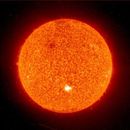
"RESURGENT SUNSPOT: Yesterday, sunspot 1024 took the day off; the fast-growing active region stopped growing and even decayed a little. Today, the sunspot is growing again. It now measures 125,000 km from end to end, almost as wide as the planet Jupiter. This 3-day movie from the Solar and Heliospheric Observatory (SOHO) shows recent developments: The size of the spot makes it a fine target for backyard solar telescopes. And it is worth watching. Sunspot 1024 is the first big sunspot of new Solar Cycle 24, and it is crackling with minor but photogenic B-class flares. By itself, this one active region won't bring an end to the deepest solar minimum in a century, but it does show that the sun's magnetic dynamo is still working--a fact some had begun to doubt. More sunspots are coming, so stay tuned."
Comment: Just when you think it's all over.....
Mystery of the Missing Sunspots, Solved?
NASA News, 17th June 2009

"The sun is in the pits of a century-class solar minimum, and sunspots have been puzzlingly scarce for more than two years. Now, for the first time, solar physicists might understand why.
At an American Astronomical Society press conference today in Boulder, Colorado, researchers announced that a jet stream deep inside the sun is migrating slower than usual through the star’s interior, giving rise to the current lack of sunspots.
Rachel Howe and Frank Hill of the National Solar Observatory (NSO) in Tucson, Arizona, used a technique called helioseismology to detect and track the jet stream down to depths of 7,000 km below the surface of the sun. The sun generates new jet streams near its poles every 11 years, they explained to a room full of reporters and fellow scientists. The streams migrate slowly from the poles to the equator and when a jet stream reaches the critical latitude of 22 degrees, new-cycle sunspots begin to appear. [...]
“This is an important discovery,” says Dean Pesnell of NASA’s Goddard Space Flight Center. “It shows how flows inside the sun are tied to the creation of sunspots and how jet streams can affect the timing of the solar cycle.” There is, however, much more to learn. “We still don’t understand exactly how jet streams trigger sunspot production,” says Pesnell. “Nor do we fully understand how the jet streams themselves are generated.”
Comment: This explanation for the lack of sunspots seems quite weak to me and the timescales are so short that this does not even seem like good science. See more comments from the more informed at Watts Up With That? where this press release from NASA has gone down like a lead balloon. See
Solar Cycle 24 lack of sunspots caused by “sluggish solar jet stream” – returning soon? By the way, according to Richard Hoagland, 19.5 degrees was the critical latitude to fit his Hyperdimensional model, but it's not far off!
Sunspots Today: A Cheshire Cat – New Essay from Livingston and Penn
Watts Up With That, 13th June 2009
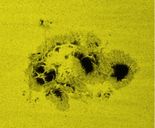 "The Cheshire Cat behavior is related to magnetic surface fields often appearing without accompanying dark spots.
"The Cheshire Cat behavior is related to magnetic surface fields often appearing without accompanying dark spots. Sunspots recently are behaving like a Cheshire Cat: the smile is there (magnetic fields) but the body is missing (no dark markings). We are unsure about past cycles but at present sunspots, with their usual umbrae and penumbrae, are failing to materialize. For hundreds of years the Sun has shown an approximately periodic 11-year alteration in its activity where the number of sunspots increases and then decreases. Sunspots are dark regions on the solar disk with magnetic field strengths greater than 1500-1800 Gauss. The last sunspot maximum occurred in 2001. Magnetically active sunspots at that time (Figure 1A) produced powerful flares, caused large geomagnetic disturbances, and disrupted some space-based technology."
Comment: Obviously, my previous references to the
Alice in Wonderland scenario, did not extend to the behaviour of the Sun! However, here we are! Please note that the evidence is now so strong that we are entering a new major phase of solar activity that scientists are now petitioning for the name of the next solar minimum. This should warn global warming alarmists to temper their viewpoint. See;
Online Petition: The next significant solar minimum should be called “The Eddy Minimum”.
Scientists Issue Unprecedented Forecast of Next Sunspot Cycle
Watts Up with that, 30th May 2009

"BOULDER—The next sunspot cycle will be 30-50% stronger than the last one and begin as much as a year late, according to a breakthrough forecast using a computer model of solar dynamics developed by scientists at the National Center for Atmospheric Research (NCAR). "
Comment: This is an old press release dated March 2006 and is useful to note, now that we have some hindsight. Please note the comment by Jeremy (18:47:05) :
"The photo is priceless. This to me summarizes the complete lack of scientific approach to everything these days. Everyone sits round a PC and blindly believes whatever nonsense it spews out. No first principles. No cause and effect. No understanding of physics, mathematics or even statistics. Just run any number of widely available computer modeling programs, fit the historical data and hey presto another science breakthrough."
Well, I have to admit that I quoted this research in my book and gave it 4 sentences that included information on NASA's "breakthrough solar forecast technique". In retrospect, it seems that one of the most reliable metaphysical sources that we are currently priviledged to host actually hinted at what was to come. As I now understand, it transpires that there is a very good reason why the planet Venus is referred to as the 'goddess of love' and it seems that the Venus transit gave us a temporary reprieve from massive blasts of solar 'male' energies, therefore helping us to balance up the energies on this planet.
New Solar Cycle Prediction: Fewer Sunspots, But Not Necessarily Less Activity
Physorg.com, 27th May 2009
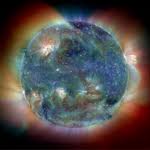
"An international panel of experts has released a new prediction for the next solar cycle, stating that Solar Cycle 24 will peak in May 2013 with a below-average number of sunspots. Led by the National Oceanic and Atmospheric Administration (NOAA) and sponsored by NASA, the panel includes a dozen members from nine different government and academic institutions. Their forecast sets the stage for at least another year of mostly quiet conditions before solar activity resumes in earnest.
"If our prediction is correct, Solar Cycle 24 will have a peak sunspot number of 90, the lowest of any cycle since 1928 when Solar Cycle 16 peaked at 78," says panel chairman Doug Biesecker of the NOAA Space Weather Prediction Center, Boulder, Colo. It is tempting to describe such a cycle as "weak" or "mild," but that could give the wrong impression. "Even a below-average cycle is capable of producing severe space weather," says Biesecker. "The great geomagnetic storm of 1859, for instance, occurred during a solar cycle of about the same size we’re predicting for 2013."
Comment: The point these solar scientists are trying to make is that sunspot count is not a very good indication of solar activity and one sunspot can generate many massive blasts. Also, by comparing the activity to 1859 they are warning us that the severity could be very high, especially as we rely on a satellite communication infrastructure that is already operating under 'extreme' conditions. With the expected increase in billions of tons of plasma charging up our solar system and the near Earth environment of space, solar scientists are warning us to expect havoc.
NOAA SWPC Solar Cycle 24 Prediction: “weakest since 1928"
Watts Up with That, 8th May 2009

"The new cycle 24 solar forecast is hot off the press from noon today, published at 12:03 PM from the Space Weather Prediction Center. It looks like a peak of 90 spots/month in May of 2013 now. SWPC has dropped their “high forecast” and have gone only with the “low forecast” as you can see in the before and after graphs that I’ve overlaid below. Place your bets on whether that “low forecast” will be an overshooting forecast or not. It has been a lot of work getting this info out as the SWPC has had trouble with their web page today. The quote of interest is:
A new active period of Earth-threatening solar storms will be the weakest since 1928 and its peak is still four years away, after a slow start last December, predicts an international panel of experts led by NOAA’s Space Weather Prediction Center." [...]
Comment: I have decided to post the details from Watts Up with That website because they have provided us with some intelligent analysis. Please note, the accompanying details from the Spaceweather.com feature story.
" May 8, 2009: A new active period of Earth-threatening solar storms will be the weakest since 1928 and its peak is still four years away, after a slow start last December, predicts an international panel of experts led by NOAA’s Space Weather Prediction Center. Even so, Earth could get hit by a devastating solar storm at any time, with potential damages from the most severe level of storm exceeding $1 trillion. NASA funds the prediction panel."
link
I believe that our experts are in a quandary, but they have decided to cover themselves anyway because the Sun has become highly unpredictable. See
Solar Scientist Ken Tapping: “No sign of the new cycle yet”. The Hathors are telling us to expect solar activity,
"In its most simple terms, there is a breach in the magnetosphere, which surrounds earth, protecting it from solar winds. Such a breach is a naturally occurring cycle, but the breadth and magnitude of this opening is quite large. It is allowing, and will allow, large volumes of plasma from the sun to enter. This will increase magnetic storms, disruptions of telecommunications, disruptions in bio-electric circuitry (such as human nervous systems), and climate change. The results of this breach and the increased charging of the magnetosphere will increase over the next several years.
See
The Holon of Ascension.
So as we enter 'A New Age dominated by space', which is now occuring as the shielding around around our solar system declines and simultaneouly Gaia lowers her shields, it seems that all predictions that Earth will provide herself with an almighty 'cleanse' seem to be accurate.
The missing sunspots: Is this the big chill?Scientists are baffled by what they’re seeing on the Sun’s surface – nothing at all. And this lack of activity could have a major impact on global warming.
The Independent, 27th April 2009
 "Could the Sun play a greater role in recent climate change than has been believed?
"Could the Sun play a greater role in recent climate change than has been believed? Climatologists had dismissed the idea and some solar scientists have been reticent about it because of its connections with those who those who deny climate change. But now the speculation has grown louder because of what is happening to our Sun.
No living scientist has seen it behave this way. There are no sunspots.
The disappearance of sunspots happens every few years, but this time it’s gone on far longer than anyone expected – and there is no sign of the Sun waking up. “This is the lowest we’ve ever seen. We thought we’d be out of it by now, but we’re not,” says Marc Hairston of the University of Texas. And it’s not just the sunspots that are causing concern. There is also the so-called solar wind – streams of particles the Sun pours out – that is at its weakest since records began. In addition, the Sun’s magnetic axis is tilted to an unusual degree. “This is the quietest Sun we’ve seen in almost a century,” says NASA solar scientist David Hathaway.
But this is not just a scientific curiosity. It could affect everyone on Earth and force what for many is the unthinkable: a reappraisal of the science behind recent global warming. "
Comment: Well, I image that the Global Warming fraternity are probably well and truly panicked now. See the technical details here,
Examining SORCE data shows the Sun continues its slide toward somnolence.
Low sunspot cycle fascinates scientists
Santa Fe New Mexican, 18th April 2009
 "Unusual trends - especially astronomical ones - are a great way to cause the public to panic. But for those worried about a strangely long trend of missing sunspots, scientists have a message: Don't expect the sun to change its spots overnight.
"Unusual trends - especially astronomical ones - are a great way to cause the public to panic. But for those worried about a strangely long trend of missing sunspots, scientists have a message: Don't expect the sun to change its spots overnight.
Sunspots are dark areas on the sun's surface caused by intense magnetic activity. They indicate a natural sort of churning caused by the rotation of plasma inside the sun. And they are often associated with things like solar flares, mass ejections and other phenomenon indicating increased solar activity. Since 2004, the sun has been in a prolonged period of low sunspot activity, which has led some to fear that the phenomenon could lead to global cooling, a new ice age, the death of the sun or even to the end of the world predicted by the Mayan calendar. [...]
One thing they've learned more about during this low sunspot period is that for astronauts, exposure to galactic cosmic radiation is much worse than exposure to solar flares or other radiation in an active solar period. [...]
"And this minimum, it's not unique yet. We've seen cycles with much lower activity and less sunspots. But the longer it continues the more interesting it is. But that's no reason to panic, yet." "
Comment: None of the 20 Mayan calendars predict the end of the world, this is a misconception being promoted by those who use their own interpretations to present the meaning of the calendars, but definitive interpretations can only be the perogative of genuine Mayan Elders. Anyway, the emphasis of this article is to reassure the public to DO NOT PANIC, YET! However, it seems certain that the article was written to point out the reasons for disquiet in certain scientific circles and reveal the helplessness of the establishment who don't like their powerlessness in the face of universal forces, exposed in such an obvious manner.
NASA spacecraft show three dimensional anatomy of a solar storm
EurekAlert! / NASA News, 14th April 2009
 "Twin NASA spacecraft have provided scientists with their first view of the speed, trajectory, and three-dimensional shape of powerful explosions from the sun known as coronal mass ejections, or CMEs. This new capability will dramatically enhance scientists' ability to predict if and how these solar tsunamis could affect Earth.
"Twin NASA spacecraft have provided scientists with their first view of the speed, trajectory, and three-dimensional shape of powerful explosions from the sun known as coronal mass ejections, or CMEs. This new capability will dramatically enhance scientists' ability to predict if and how these solar tsunamis could affect Earth.
When directed toward our planet, these ejections can be breathtakingly beautiful and yet potentially cause damaging effects worldwide. [...] However, ejections can produce a form of solar cosmic rays that can be hazardous to spacecraft, astronauts and technology on Earth.
Space weather produces disturbances in electromagnetic fields on Earth that can induce extreme currents in wires, disrupting power lines and causing wide-spread blackouts. These sun storms can interfere with communications between ground controllers and satellites and with airplane pilots flying near Earth's poles. Radio noise from the storm also can disrupt cell phone service. Space weather has been recognized as causing problems with new technology since the invention of the telegraph in the 19th century. [...]
"Before this unique mission, measurements and the subsequent data of a CME observed near the sun had to wait until the ejections arrived at Earth three to seven days later," said Angelos Vourlidas, a solar physicist at the Naval Research Laboratory in Washington. Vourlidas is a project scientist for the Sun Earth Connection Coronal and Heliospheric Investigation, STEREO's key science instrument suite. "Now we can see a CME from the time it leaves the solar surface until it reaches Earth, and we can reconstruct the event in 3D directly from the images."
These ejections carry billions of tons of plasma into space at thousands of miles per hour. This plasma, which carries with it some of the magnetic field from the corona, can create a large, moving disturbance in space that produces a shock wave. The wave can accelerate some of the surrounding particles to high energies that can produce a form of solar cosmic rays. This process also can create disruptive space weather during and following the CME's interaction with Earth's magnetosphere and upper atmosphere. "
Comment: Here we see a new Space Weather system being deployed that will give us more time on Earth to mitigate the possible damage from highly charged solar and cosmic particles that literally "zap" Earth, as NASA have stated in press releases in the past.
NASA: Deep Solar Minimum
NASA News, 1st April 2009

The sunspot cycle is behaving a little like the stock market. Just when you think it has hit bottom, it goes even lower. 2008 was a bear. There were no sunspots observed on 266 of the year's 366 days (73%). To find a year with more blank suns, you have to go all the way back to 1913, which had 311 spotless days: plot. Prompted by these numbers, some observers suggested that the solar cycle had hit bottom in 2008. Maybe not. Sunspot counts for 2009 have dropped even lower. As of March 31st, there were no sunspots on 78 of the year's 90 days (87%). It adds up to one inescapable conclusion:
"We're experiencing a very deep solar minimum," says solar physicist Dean Pesnell of the Goddard Space Flight Center.
"This is the quietest sun we've seen in almost a century," agrees sunspot expert David Hathaway of the Marshall Space Flight Center. [...]
All these lows have sparked a debate about whether the ongoing minimum is "weird", "extreme" or just an overdue "market correction" following a string of unusually intense solar maxima.
"Since the Space Age began in the 1950s, solar activity has been generally high," notes Hathaway. "Five of the ten most intense solar cycles on record have occurred in the last 50 years. We're just not used to this kind of deep calm."
Comment: "We're just not used to this kind of deep calm." Yes, but is it the calm before the storm?
Giant Solar Twists Discovered
Science Daily, 20th March 2009

"Scientists at Queen's University have made a finding that will
help us to understand more about the turbulent solar weather and its affect on our planet. Along with scientists at the University of Sheffield and California State University, the researchers have detected giant twisting waves in the lower atmosphere of the Sun. [...] Professor Mihalis Mathioudakis, leader of the Queen's University Solar Group, said:
"Understanding solar activity and its influence on the Earth's climate is of paramount importance for human kind. The Sun is not as quiet as many people think. "The solar corona, visible from Earth only during a total solar eclipse, is a very dynamic environment which can erupt suddenly, releasing more energy than ten billion
atomic bombs. Our study makes a major advancement in the understanding of how the million-degree corona manages to achieve this feat.""
Comment: Well, something has happened in the scientific community, because they are admitting here that Space Weather is effecting our planet's climate.
THIS IS A MAJOR CHANGE!
When I wrote my book, the prevailing attitude in the scientific community was understanding Space Weather effects on our satellite communication infrastructure, national power grids, pipelines and electronic systems, etc. Anyway, I note that this article can't even get the details right about Hannes Alfvén (1908-1995), who won the Nobel Prize in
1970. His ideas of galactic magnetism proposed in 1937 took three decades to get any recognition and it seems another of his theories described in this article, has taken over 60 years to be observed and proven. He understood that we live in a Plasma Universe and this plasma is now swamping our planet. We are facing completely new challenges and it's not just plasma physicists and electrical engineers that have to understand the effects on our planet and technology. We all need to understand that as electromagnetic beings, how we can live in a highly electrified/spiritualised world.
Space agencies planning for sun-nuzzling satellite
Scientific America, 20th March 2009

The European Space Agency (ESA) and NASA today announced their preliminary selections for the instruments that will fly aboard ESA's forthcoming Solar Orbiter satellite, which will orbit the sun closer than ever before.
The satellite, sometimes known as SOLO, will keep tabs on the sun and the space weather it creates from a cozy position next to our star - inside the orbit of Mercury and less than one-fourth the distance from Earth to the sun. (By comparison, NASA and ESA's currently operating Solar and Heliospheric Observatory, or SOHO, is positioned much farther out - roughly 99 percent of the way from the sun to Earth.) SOLO will also provide a rare glimpse of the polar regions of the sun."
Comment: I am sure this satellite will provide some good data if they can launch it safely and get it past all the debris around Earth.
NASA solicits new studies on the current solar minimum
Watts Up With That, 12th March 2009

"This is interesting. It seems that NASA has taken an interest in the current solar minimum and is getting ready to launch one or more studies about it. They are soliciting proposals. [...] Michael Ronanye writes:
This is a three year project with funding of 1.5 million dollars per year and total funding of 4.5 million dollars over the life of the project. This is a very good insurance and CYA policy on NASA's part. They may get some interesting research out of the project and if conditions on the Sun take an unexpected turn, they can always say: "Yes Senator, NASA was right of top of the situation and we funded this new project on 3/5/2009"!"
B.9 CAUSES AND CONSEQUENCES OF THE MINIMUM OF SOLAR CYCLE 23
1. Scope of Program
In 2009, we are in the midst of the minimum of solar activity that marks the end of Solar Cycle 23. As this cycle comes to an end we are recognizing, in retrospect, that the Sun has been extraordinarily quiet during this particular Solar Cycle minimum. This is evidenced in records of both solar activity and the response to it of the terrestrial space environment. For example:
Causes – Solar output
- Lowest sustained solar radio flux since the F 10.7 proxy was created in 1947;
- Solar wind global pressure the lowest observed since the beginning of the Space age;
- Unusually high tilt angle of the solar dipole throughout the current solar minimum;
- Solar wind magnetic field 36% weaker than during the minimum of Solar Cycle 22;
- Effectively no sunspots;
- The absence of a classical quiescent equatorial streamer belt; and
- Cosmic rays at near record-high levels.
Consequences
- With the exception of 1934, 2008 had more instances of 3-hr periods with Kp=0 than any other year since the creation of the index in 1932;
- Cold contracted ionosphere and upper atmosphere; and
- Remarkably persistent recurrent geomagnetic activity.
Thus, we have an unprecedented opportunity to characterize the quiet/background state of the heliosphere when the solar source function is as close to the ground state as it has been in the modern era.[end of excerpt]
Comment: Remember this is our Sun that is now clearly not performing to expectations and the above listing provides us with some solid facts. We are in unchartered waters as the Sun is
rapidly dropping our solar shield to oncoming cosmic, galactic and intergalactic energies. Hmmm..... OK when I wrote my book, I was sure that we were seeing the start of a New Age dominated by space or ether, with the phenomena of Space Weather, but this is now on a completely different scale, as predicted by channelled sources and dutifully included in my book..... Well, we can now state that NASA has officially got off the fence.....
Space Weather Prediction Center moves the solar cycle goalpost again
Watts Up With That, 26th February 2009

"SWPC has just made a change in their solar cycle predictions in the middle of the month without any preannouncement. Both Sunspot and F10.7cm predictions were altered significantly."
Comment: Hmmm.... This is our Sun that all life on this planet depends on and it is behaving in a unprecedented and unexpected manner. What's more, the research from the 1980s tells us that a Sun without sunspots actually delivers more "transported energy" contrary to all expectations, so it seems that our scientists are just now being totally confounded.
Now well over 30 days without a cycle 24 sunspot
Watts Up With That, 21st February 2009
 Comment:
Comment: The only reason for this entry is the comments and the discussion in the forum about the Sun being a spherical plasma generator, which underscores just how far the scientific community have woken up to the reality that we live in a Plasma Universe. However the comment by Geoff Pohanka (07:55:18) is priceless:
"The real problem is that the policy in makers in Washington are desperate to enact stong environmental legislation and have been making even more outlandish statements about the environment to whip people up in order to cram their legislation through before the truth is known about the drivers of the climate. They do not want to wait to see which wins, CO2 or the sun. They probably fear that CO2 isnt the driver but they dont want to give up the power the control of CO2 gives them. I think there is a parallel here with J.R.R. Tolkein's books "Lord of the Rings". The ring had an alluring power, it was the ring of power. One ring to rule them all, one ring to bind them. I think the ring of power is CO2. C…O…2, with the O being this modern day ring, When you control CO2 you control everything living on earth."
Quite an interesting analogy.
B1-class solar flare, Feb. 10th at 2310 UT.
SpaceWeather.com, 11th February 2009

Full report: "SOLAR FLARE: Yesterday, Feb. 10th at 2310 UT, Earth-orbiting satellites detected a B1-class solar flare. Normally, such a small eruption would pass unremarked, but during this deep solar minimum, it's a relatively big event. NASA's STEREO-B spacecraft photographed the probable blast-site shortly before and after the eruption: The source of the explosion appears to be a collapsing (or erupting) magnetic filament. The filament was present before the flare, absent afterward. Higher-cadence imagery from the Solar and Heliospheric Observatory (SOHO) may confirm or refute this idea; however, those images have not yet been beamed back to Earth. Stay tuned for updates."
Comment: Has the Sun finally stirred? The last time the Sun was this inactive between solar maximums, what followed was an historic high, so the anticipation and speculation will continue until Sun watchers are sure we have started a new solar cycle.
Update from spaceweather.com "Sunspot 1012 is crackling with B-class solar flares. Yesterday, Feb. 12th at 1625 UT, one such eruption propelled a "solar tsunami" through the sun's lower atmosphere. An ultraviolet telescope onboard NASA's STEREO-B spacecraft recorded the faint yet powerful wave: The low latitude and magnetic polarity of this sunspot identify it as a member of old Solar Cycle 23. It is, in other words, a fossil, albeit a relatively active one. Stay tuned for more flares."
The new NASA solar goalpost: Cycle 24, maybe not so big
wattsupwiththat.com, 8th January 2009

"A few days ago I wrote in State of the Sun for year end 2008: all's quiet on the solar front - too quiet that "No new cycle 24 predictions have been issued by any solar group (that I am aware of ) in the last couple of months."
Coincidentally and shortly after that, NASA's David Hathaway updated his solar prediction page here. He's made a significant backtrack over previous predictions, and now for the first time he is claiming cycle 24 will be less than cycle 23, not greater."
Comment: Well, there seems to be some confusion at NASA. Maybe David Hathaway, was not aware of the impending report about the massive breach in the Earth's magnetic field, the weakened ionosphere and the report of the impact of severe Space Weather on our modern day technology based society. Sunspot numbers are only a general indicator of solar activity, because its what comes out of them in terms of solar flares and coronal mass ejections (CMEs) that is important.
Sun Often 'Tears Out A Wall' In Earth's Solar Storm Shield
Physorg.com, 16th December 2008
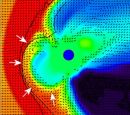
Earth's magnetic field, which shields our planet from particles streaming outward from the Sun, often develops two holes that allow the largest leaks, according to researchers sponsored by NASA and the National Science Foundation. "The discovery overturns a long-standing belief about how and when most of the solar particles penetrate Earth's magnetic field, and could be used to predict when solar storms will be severe. [...]
Surprisingly, recent observations by the THEMIS spacecraft fleet demonstrate that the opposite is true. "Twenty times more solar particles cross the Earth's leaky magnetic shield when the sun's magnetic field is aligned with that of the Earth compared to when the two magnetic fields are oppositely directed," said Marit Oieroset of the University of California, Berkeley, lead author of one of two papers on this research, published May 2008 in Geophysical Research Letters. [...]
Comment: This physorg.com report gives slightly more technical details on the NASA THEMIS discovery. It highlights the issue of our scientists being faced with the new phenomena of Space Weather and previously unknown geomagnetic conditions that completely confound our scientific understanding, such that current theory has to be scrapped and replaced to match the hard evidence of observational data. The observation of a massive tear 7 Earths wide by 4 Earths high is certainly incredible and in the future, it means Earth will be exposed to geomagnetic storms of billions of tons of plasma, highly charged sub-atomic particles that will result in Earth becoming increasingly electrified and spiritualised.
Solar Flare Surprise: Stream Of Perfectly Intact Hydrogen Atoms Detected
Science Daily, 15th December 2008
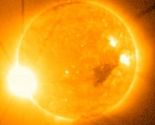
"Solar flares are the most powerful explosions in the solar system. Packing a punch equal to a hundred million hydrogen bombs, they obliterate everything in their immediate vicinity. Not a single atom should remain intact. At least that's how it's supposed to work.
"We've detected a stream of perfectly intact hydrogen atoms shooting out of an X-class solar flare," says Richard Mewaldt of the California Institute of Technology. "What a surprise! If we can understand how these atoms were produced, we'll be that much closer to understanding solar flares. [...]
The event occurred on Dec. 5, 2006. A large sunspot rounded the sun's eastern limb and with little warning it exploded. On the "Richter scale" of flares, which ranks X1 as a big event, the blast registered X9, making it one of the strongest flares of the past 30 years."
Comment: I am sure this discovery will be hotly debated in astrophysics world, but at the moment, these scientists are only speculating about another observation that falsifies the popular Solar Fusion Model.
21 spotless days and solar magnetic field still in a funk
WattsUpWithThat.com, 9th December 2008

"We are now at 21 days with no sunspots, it will be interesting to see if we reach a spotless 30 day period and then perhaps a spotless month of December. [...]
What I find most interesting about the Geomagnetic Average Planetary Index graph above is what happened around October 2005. Notice the sharp drop in the magnetic index and the continuance at low levels. Read on for more. This looks much like a "step function" that I see on GISS surface temperature graphs when a station has been relocated to a cooler measurement environment. In the case of the sun, it appears this indicates that something abruptly "switched off" in the inner workings of the solar dynamo. Note that in the prior months, the magnetic index was ramping up a bit with more activity, then it simply dropped and stayed mostly flat."
Comment: It's fascinating that Anthony Watts keeps insisting that something switched off in the Sun in October 2005, see graph for details. Yet, he is linking this to when global sea levels began to lose its upward trend. Whatever, if the Sun remains quiet, this will mean that more galactic cosmic radiation will reach the Earth, at the same time that we are reaching our maximum alignment with the galactic centre and metaphysical sources specify a 100,000 X year on year increase in the energies of evolution from the galactic centre in the time period 2007-2012. We are living in incredible times!
Sun's Magnetic Field May Impact Weather And Climate: Sun Cycle Can Predict Rainfall Fluctuations
Science Daily, 3rd December 2008
 "The sun's magnetic field may have a significant impact on weather and climatic parameters in Australia and other countries in the northern and southern hemispheres.
"The sun's magnetic field may have a significant impact on weather and climatic parameters in Australia and other countries in the northern and southern hemispheres. According to a study in Geographical Research, the droughts are related to the solar magnetic phases and not the greenhouse effect. The study uses data from 1876 to the present to examine the correlation between solar cycles and the extreme rainfall in Australia. [...]
Professor Baker adds, "This discovery could substantially advance forecasting from months to decades. It should result in much better long-term management of agricultural production and water resources, in areas where rainfall is correlated to SOI and El Niño (ENSO) events.""
Comment: Some weather forecasters already understand the connection between the Earth and the Sun's magnetic field and hence have high weather prediction success rates. See also 18 July 2008 report
Sun Could Cause 15% To 20% Of Effects Of Climate Change, Researcher Says
C1.6 Flare / Sunspot 1007 Update
Solarcycle24.com, 3rd November 2008
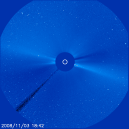
"A C1.6 solar flare took place today at 11:19 UTC. There will continue to be a chance for B class flares from Sunspot 1007. There may remain a slight chance for a C-Class flare from this region, but it is starting to wear itself down it appears.
The first flare activity of Solar Cycle 24 took place Sunday originating from Sunspot 1007. Multiple B-Class mini flares including a B7.2 and B5.7 was observed."
Comment: Well, it seems the Sun has finally woken up from it's
long nap, there was even a coronal mss ejection (CME), but nothing too exciting yet.
Update 5th November
"There is a possible active region on the farside of the sun that is producing countless CME's. In the past 24 hours there was at least 2 of them observed in the latest Lasco Movies." Click on this link to watch the
Joyfire Spaceweather Explorer.
From Spaceweather.com we are told, "Magnetic fields above sunspot 1007 erupted yesterday, Nov. 3rd, sparking a B8-class solar flare. Although B-flares are considered minor, the blast nevertheless made itself felt on Earth. X-rays bathed the dayside of our planet and sent a wave of ionization rippling through the atmosphere over Europe. The sudden ionospheric disturbance (SID) disrupted propagation of VLF radio signals, a phenomenon recorded by Rudolf Slosiar of Bojnice, Slovakia." I have to say, I am wondering about the timing.....
Ulysses Reveals Global Solar Wind Plasma Output At 50-Year Low
NASA News, 23rd September 2008
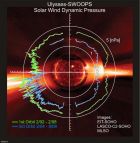
WASHINGTON -- Data from the Ulysses spacecraft, a joint NASA-European Space Agency mission, show the sun has reduced its output of solar wind to the lowest levels since accurate readings became available.
The sun's current state could reduce the natural shielding that envelops our solar system.
"Galactic cosmic rays carry with them radiation from other parts of our galaxy," said Ed Smith, NASA's Ulysses project scientist at the Jet Propulsion Laboratory in Pasadena, Calif. "With the solar wind at an all-time low, there is an excellent chance the heliosphere will diminish in size and strength. If that occurs, more galactic cosmic rays will make it into the inner part of our solar system.
Comment: It's official, Earth's shielding against Space Weather is dropping quickly. The New Cosmic Age has arrived! Well, if the Universe was going to take the opportunity to blast our planet with galactic cosmic rays, it seems that our defenses are well and truly down to do anything much about it. When I wrote my book, I was very cautious and only quoted NASA's anxiety about heightened solar activity at 2012 and so I emphasised the combination of solar, cosmic and galactic energy driving evolutionary change on Earth. Now if there is a "surge" of galactic energy or even a galactic superwave coming our way, that would coincide with promised increases in energy x 100,000 year on year from 2007 - 2012.
Update 26th September At this time, I am in a state of awe and jubilation that my understanding that
Space Weather, the culmination of solar, cosmic and galactic energy is driving evolutionary change on Earth, is being vindicated over and over again. Now that NASA has taken this unprecedented step in telling the world that EVERY LIVING THING ON THIS PLANET WILL BE SUBJECT TO MORE COSMIC & GALACTIC ENERGY IN THE YEARS AHEAD, I hope more people will start to understand that the resultant will be evolutionary change, as many scientists have claimed has occured in the past, from studying the evidence. Therefore, this must be understood by all;
"It is not the strongest of the species that survives, nor the most intelligent. It is the one that is most adaptable to change." .....Charles Darwin
NASA’s press conference on the state of the sun
Watts Up With That?, 23rd September 2008

"just finished participating in the press teleconference call in for reporters with NASA and their panel of solar experts today. There was a lot of interesting discussions and questions. Unfortunately even though I put in for a question, I was shut out, and judging from the order of the questions asked and the organizations represented, clearly they played favorites for getting maximum exposure by choosing the larger media outlets first, such as AP’s Seth Borenstein who got the first question."
Comment: From the media teleconference witness report given here, NASA seem to be as evasive as ever, this is why NASA's acronym is often quoted as, NEVER A STRAIGHT ANSWER!
Sun Makes History: First Spotless Month in a Century
Daily Tech, 1st September 2008

"The sun has reached a milestone not seen for nearly 100 years: an entire month has passed without a single visible sunspot being noted. The event is significant as many climatologists now believe solar magnetic activity – which determines the number of sunspots -- is an influencing factor for climate on earth."According to data from Mount Wilson Observatory, UCLA, more than an entire month has passed without a spot. The last time such an event occurred was June of 1913. Sunspot data has been collected since 1749."
Comment: See,
Sunspeck counts, Sun Does Not have Spotless Month . I find it amusing that scientists are now arguing over 'specks' on the Sun!
Solar radio waves could signal global cooling
National Post, 11th August 2008

"Those who view the Sun, and not CO2, as a driver of temperatures on Earth look to various measures of solar activity for explanations of climate change. For one such measure -- radio waves from the Sun, or solar flux – they look to Canada's Dominion Radio Astrophysical Observatory in the Okanagan valley, near Penticton, British Columbia. What they find supports the view that another Little Ice Age could be coming."
Comment: Hmmm.... There are a number of factors that point to the same conclusion and some of the more balanced members of the scientific community have already started to realise this too.....
A huge solar flare (CME) Credit: NASA (April 2001)
YouTube, 19th July 2008
 Comment:
Comment: This is a recently released coronagraph compilation by NASA for April 2001. Hmmm....I suppose NASA are trying to prepare people, as the current depth of the Sun's slumber must be very worrying.... What's interesting, is that the massive X-rated solar flares were even bigger in 2003, but often the monitoring X-ray detectors could not cope and were often totally blinded. Incidentally, the X-rating was only introduced in the mid 1990s when the activity of the Sun just went off the charts. Who knows what will happen if NASA's own predictions come true for the peak of the next solar cycle which will probably be around 2012.... We live in a world highly dependent on technology which can be disrupted by fluctuating geomagnetic storms. For example the last massive geomagnetic storm in December 2006 (the biggest burst of electromagnetic energy in 30 years), caused effects on GPS that were 10x bigger than ever recorded. Yet, by 2012 the plans are to have all planes operated by GPS....sigh!
Former NASA Space Shuttle Flight Director Tells of Solar Flare Scare
Earth Changes Media, 15th July 2008
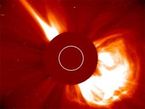
"Wayne Hale is the former NASA space shuttle flight director. In a recent
article, Hale tells of some very intense moments regarding the space shuttle and
solar flares. This story is being released for the first time and ECM is
bringing this very telling news to you."
For subscribers only: A copy can be found
here
Comment: I note that Mitch Battros is now informing people of the impact of geomagnetic storms on the human energy field, so my interview by him in April 2007 did make a difference, good!
What's Wrong with the Sun? (Nothing)
Physorg.com, 11th July 2008

"This report, that there's nothing to report, is newsworthy because of a growing buzz in lay and academic circles that something is wrong with the sun. Sun Goes Longer Than Normal Without Producing Sunspots declared one recent press release. A careful look at the data, however, suggests otherwise."
"Hathaway has studied international sunspot counts stretching all the way back to 1749 and he offers these statistics: "The average period of a solar cycle is 131 months with a standard deviation of 14 months. Decaying solar cycle 23 (the one we are experiencing now) has so far lasted 142 months--well within the first standard deviation and thus not at all abnormal. The last available 13-month smoothed sunspot number was 5.70. This is bigger than 12 of the last 23 solar minimum values." In summary, "the current minimum is not abnormally low or long." The longest minimum on record, the Maunder Minimum of 1645-1715, lasted an incredible 70 years."
Comment: I think they call this type of report damage limitation, I assure you, Sun watchers are very nervous.....
Sun in deep slumber: 10.7 solar flux
hits record low value
Watts Up With That, 16th June 2008
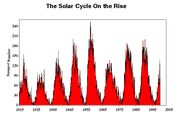
"NRC Canada's FTP site which logs the daily 10.7 centimeter (2800 megahertz) radio flux from the sun just reported what appears to be a new record low in the observed data."
Comment: As noted by a commentator, "From Solar Cycle 24 (www.solarcycle24.com): "Today the solar flux has dipped to a new low of 64.2. Just so you do not worry too much, on July 2, 1954 a value of 64.4 was
observed. What followed was one of the strongest Cycles ever recorded (Solar Cycle 19)." Hmmm...
More Signs Of The Sun Slowing Down
Watts Up With That, 15th June 2008

In my post from yesterday, I highlighted a paragraph from a NASA press release which touched on one of the final findings of the soon to be ended Ulysses spacecraft mission to study the sun:
"Ulysses ends its career after revealing that the magnetic field emanating from the sun�s poles is much weaker than previously observed. This could mean the upcoming solar maximum period will be less intense than in recent history."
Comment: Evolutionary Change is being driven by solar, cosmic and
GALACTIC energy! Well, I am sure some people think we will be 'saved' from
being fried by the Sun as the Sun's activity seems to be waning. Yet, this scenario also
means that the Sun's heliosphere is not 'batting away' as many cosmic and galactic rays and so we will get bigger doses of that type of energy instead......I have to say the timing suggests there is a strong correlation here with metaphysical predictions. I have to say this is all starting to look quite brilliant!
Cartwheel Coronal Mass Ejection
NASA News, 27th May 2008
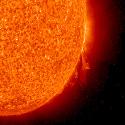
"Imagine a billion-ton cloud of gas launching itself off the surface of the sun and then ... doing a cartwheel. That's exactly what happened on April 9, 2008, when a coronal mass ejection or "CME" pirouetted over the sun's limb in full view of an international fleet of spacecraft. Even veteran solar physicists were amazed.
But that's not all. While one part of the cloud did a cartwheel, another part did a backflip at the same time. As strange as it sounds, this could be the normal way solar explosions unfold, say researchers analyzing the data."
Comment: It looks like they captured the energy being released in the energetic pattern of an infinity sign to me; ∞, the metaphysical symbol for balance and harmony.....
Ulysses Flyby of the Sun's North Pole
NASA Science News, 14th January 2008
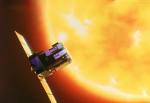
"Many researchers believe the sun's poles are central to the ebb and flow of the solar cycle. Consider the following: When sunspots break up, their decaying magnetic fields are carried toward the poles by vast currents of plasma. This makes the poles a sort of "graveyard for sunspots." Old magnetic fields sink beneath the polar surface two hundred thousand kilometers deep, all the way down to the sun's inner magnetic dynamo. There, dynamo action amplifies the fields for use in future solar cycles. This week,
"Ulysses will measure the sun's magnetic field above the North Pole to see what it's like during the change of solar cycles," says Posner."
Massive Explosion Reported On Sun
Spaceweather.com, 25th February 2008

"Yesterday, something behind the sun's northeastern limb exploded, hurling a bright cloud into space. This could herald an active sunspot just over the horizon. If so, solar rotation will bring it into view this week."
Comment: Well, the Sun has been eerily quiet, and then suddenly we get a blast from nowhere. This one was facing away from us, maybe Earth will score a direct hit next time. There are really not that many people prepared for the electromagnetic onslaught on their energy field. Now the Earth has a new electrical wiring in the form of the "Paradise Grid" we don't have to worry there, but the significance of the effect on the human energy field is largely unknown. My book "Tuning the Diamonds: Electromagnetism & Spiritual Evolution" does explain the significance — in plain English.
Solar Cycle 24 has officially started
Watts Up With That, 4th January 2008

"Solar physicists have been waiting for the appearance of a reversed-polarity sunspot to signal the start of the next solar cycle. The signal for the start of a new cycle is sighting a particular kind of sunspot. That wait is over. A magnetically reversed, high-latitude sunspot, dubbed as number 981, emerged on the surface of the sun today. Just a few months ago, an "All Quiet Alert" had been issued for the sun. This reversed polarity sunspot today marks the beginning of Solar Cycle 24 and the sun’s return back to Solar Maximum."
Comment: Solar Cycle 24 has started late and is expected to be historic!
Is a New Solar Cycle Beginning?
NASA News, December 14, 2007
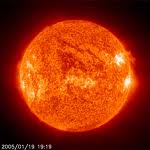 "The solar physics community is abuzz this week.
"The solar physics community is abuzz this week. No, there haven't been any great eruptions or solar storms. The source of the excitement is a modest knot of magnetism that popped over the sun's eastern limb on Dec. 11th."
"New solar cycles always begin with a high-latitude, reversed polarity sunspot," explains Hathaway. "Reversed polarity " means a sunspot with opposite magnetic polarity compared to sunspots from the previous solar cycle. "High-latitude" refers to the sun's grid of latitude and longitude. Old cycle spots congregate near the sun's equator. New cycle spots appear higher, around 25 or 30 degrees latitude. The region that appeared on Dec. 11th fits both these criteria. It is high latitude (24 degrees N) and magnetically reversed. Just one problem: There is no sunspot. So far the region is just a bright knot of magnetic fields.
"Many forecasters believe Solar Cycle 24 will be big and intense. Peaking in 2011 or 2012, the cycle to come could have significant impacts on telecommunications, air traffic, power grids and GPS systems. (And don't forget the Northern Lights!) In this age of satellites and cell phones, the next solar cycle could make itself felt as never before."
Comment: There is also the additional problem of the deluge of electromagnetic energy effecting the human energy field, especially the central nervous system.
Roiling magnetic waves explain solar enigma
Movie Camera
New Scientist Space, December 6, 2007
 The Plasma Universe! "Magnetic waves ripple through the Sun's outer atmosphere with enough energy to heat the region to its astonishing temperature of millions of degrees, new views from the Hinode spacecraft suggest. If correct, the waves could solve a decades-long puzzle about the source of this heat.
The Plasma Universe! "Magnetic waves ripple through the Sun's outer atmosphere with enough energy to heat the region to its astonishing temperature of millions of degrees, new views from the Hinode spacecraft suggest. If correct, the waves could solve a decades-long puzzle about the source of this heat.
Comment: The Sun is a huge ball of plasma, the satellite images capture exactly the same as you could recreate in a plasma laboratory. It makes you wonder why the surprise....
Place your bets for Solar Cycle 24
Solar Science, 21th November 2007
 "NASA is in two minds about the next solar cycle, and so it’s time to place your bets:
"NASA is in two minds about the next solar cycle, and so it’s time to place your bets: You could approach this as a shoot-out between competing hypotheses of solar variation and watch the fun. Alternatively, you could choose the
Modern Science Method:
1. Form clique of friends
2. Announce new “ground-breaking paper” to the press. Announce “result” in soundbite form.
3.Get papers published peer reviewed by friends
4. Go to United Nations and declare “the science is settled”
5. Denigrate other scientists who disagree with you as “Deniers” and in league with [insert scary corporation here]
6. Praise other “independent” scientific papers written by your friends which miraculously support your hypothesis.
7. Repeat the above two processes so that you and your friends get lions share of grant money while your opponents are starved of funding and attention.
8. Hide data/methodology so as to prevent replication. Make sure only copy of data is on a floppy disk and never, ever backed up like normal people.
9. Start weblog.
10. When cornered, declare that “science has moved on”
It could go on for years."
Read remainding blog entries.
Solar wind warming up Earth
RIA Novosti, 28th September 2007
 "Yury Leonov, director of the Institute of Geology at the Russian Academy of Sciences, thinks that the human impact on nature is so small that it can be dismissed as a statistical mistake."
"Yury Leonov, director of the Institute of Geology at the Russian Academy of Sciences, thinks that the human impact on nature is so small that it can be dismissed as a statistical mistake." [...]
"Some dangers are much less discussed today, for instance, the inversion of the Earth's magnetic field," Zeleny warns. "It is gradually changing its polarity; the poles are crawling to the equator at increasing speed. There were whole epochs in the Earth's history when the magnetic field all but disappeared. Such oscillations have taken place throughout almost its entire geological history."
Paleomagnetic data show that last time the magnetic field disappeared was several hundred thousand years ago. It is possible that the Earth will lose it again in the 21st and 22nd centuries. The "magnetic umbrella," which protects us from deadly space radiation, will disappear, exposing humankind to a heavy "rainfall" of solar particles and space rays. Our descendants will have to understand how a weaker magnetic field will affect the climate and what protection they will need."
Comment: Thank God for the Russians, you can also rely on them to provide some balance!
Nice discussion here about the solar wind and it's influence on Earth's climate, there is also a very rare mention of the influence on the Earth's magnetic field. The following exerpt is worth knowing as the rain of electromagnetic energy intensifies.
Study: Sun sounds cause the Earth to shake
Science Daily, 20th August 2007
 PARIS -- European Space Agency scientists have proved sounds generated deep inside the sun cause the Earth to shake and vibrate.
PARIS -- European Space Agency scientists have proved sounds generated deep inside the sun cause the Earth to shake and vibrate.
Researchers involved in the HISCALE experiment -- Heliosphere Instrument for Spectra, Composition and Anisotropy at Low Energies -- aboard the Ulysses spacecraft also found Earth's magnetic field, atmosphere and terrestrial systems are also affected by the sound vibrations.
The researchers -- David Thomson, Louis Lanzerotti, Frank Vernon, Marc Lessard and Lindsay Smith -- have determined distinct, isolated tones, predicted to be generated by pressure and gravity waves in the sun, manage to reach Earth and are detectable in our environment.
The scientists discovered the tones in seismic data and have found them in voltages induced on ocean cables, along with a wide variety of terrestrial systems.
Although the tones are all around us, they are undetectable by the human ear.
The Ulysses spacecraft is a joint project of the European Space Agency and the National Aeronautics and Space Administration.
Comment: The recent scientific discoveries of the interaction of sound, geometry and magnetism within our plasma sun means the fusion model has been falsified. It also has deep implications for multi-dimensional theories and the delivery mechanism for the source of our reality.
Princeton Scientists Confirm Long-Held Theory About Source Of Sunshine
Space Daily, 21st August 2007

In stars the size of the sun, most solar energy is produced by a complex chain of nuclear reactions that converts hydrogen into helium. Beginning with protons from hydrogen's nucleus, the chain takes one of several routes that all end with the creation of a helium nucleus and the production of sunlight.
Steps along two of these routes require the presence of the element beryllium, and physicists have theorized that these steps are responsible for creating about 10 percent of the sun's neutrinos. But technological limitations had made the theory difficult to test until now.
The Gran Sasso lab's giant Borexino detector, located more than a kilometer below the Earth's surface, overcame these limitations, permitting the team to observe low-energy neutrinos, which interact extremely rarely with other forms of matter. Scientists have desired a way to detect them, because they emerge largely unchanged from their journey through the sun's interior to the Earth -- offering an unsullied glimpse into the processes that forged them.[...]
"The findings show that science's understanding of the chain of nuclear processes that make the sun shine is essentially correct, as least as far as the part of the chain that involves beryllium is concerned," Calaprice said.
"The reaction does not generate a large percentage of the sun's energy, but confirming that we understand it makes us more certain that we know how the other processes that create sunlight work."
Comment: There is some confusion caused by the use of the term sunshine when in fact these scientists were refering to the chain of nuclear reactions that produce neutrinos as a by product.....
Water Experts Find Earth's Warming, Rainfall Linked to Sun
CGFI, 26 July 2007

A team of water experts says the pattern of droughts and floods in South Africa shows our global warming was triggered by the variability of the sun's irradiance rather than by human-emitted CO2. They say variations in South African rainfall patterns are keyed to periodic reversals of the sun's magnetic field and to the constantly changing distance between the sun and the earth as both move through space.
In South Africa, alternate 11-year sunspot cycles produce opposite rainfall results. One complete “double sun cycle occurs every 20.8 years: the first cycle brings a big flood, followed by a small drought; the next brings a big drought, followed by a small flood.
Lead author Will Alexander used the double sunspot cycle to publicly predict the end of major South African droughts in both 1995 and 2006. He notes that South African droughts have often been broken at 11-year intervals by severe floods associated with sunspot maxima as in 1822, 1841, 1863, 1874 and 1885. The research summary appears in the June 2007 issue of the Journal of the South African Institution of Civil Engineering.
Comment: This article makes it very clear that
"pattern of droughts and floods in South Africa shows our global warming was triggered by the variability of the sun’s irradiance rather than by human-emitted CO2". The last statement shows just how much the Al Gore camp are in trouble; "The evidence for a sun/climate connection keeps pouring in, while all we hear from the Kyoto crowd is
"The computer models agree with each other."
The truth is, we can't ignore the sun
Sunday Telegraph, 15 July 2007

According to the headlines last week, the sun is not to blame for recent global warming: mankind and fossil fuels are. So Al Gore is correct when he said, "the scientific data is in. There is no more debate."
Of that the evangelical BBC had no doubt. There was an air of triumphalism in its coverage of the report by the Royal Society.
It was perhaps a reaction to the BBC Trust's recent criticism of the Corporation's bias when reporting climate change: but sadly, it only proved the point made by the Trust.
The BBC was enthusiastically one-sided, sloppy and confused on its website, using concepts such as the sun's power, output and magnetic field incorrectly and interchangeably, as well as not including any criticism of the research.
But there is a deeper and more worrying issue. Last week's research is a simple piece of science and fundamentally flawed. Nobody looked beyond the hype; if they had, they would have reached a different conclusion.
"The sun is by far the single most powerful driving force on our climate, and the fact is we do not understand how it affects us as much as some think we do."
So look on the BBC and Al Gore with scepticism. A scientist's first allegiance should not be to computer models or political spin but to the data: that shows the science is not settled.
Comment: It is obvious by doing any basic research into the many different disciplines of climate science that our scientists cannot reach a concensus view, because the subject is so complex. It totally amazes me that the European Space Agency quietly announced in 2003 that dust was entering our solar system at an increasing rate, scheduled to peak in 2012, but neatly side-stepped the impact on our Sun. The next solar cycle will be a total shock to many climate scientists, as solar activity is predicted to "zap" Earth.
Magnetic Field Uses Sound Waves to Ignite Sun's Ring of Fire
National Science Foundation, 29th May 2007

Sound waves escaping the sun's interior create fountains of hot gas that shape and power a thin region of the sun's atmosphere which appears as a ruby red "ring of fire" around the moon during a total solar eclipse, according to research funded by the National Science Foundation (NSF) and NASA.
The results are presented today at the American Astronomical Society's Solar Physics Division meeting in Hawaii.
This region, called the chromosphere because of its color, is largely responsible for the deep ultraviolet radiation that bathes the Earth, producing the atmosphere's ozone layer.
It also has the strongest solar connection to climate variability.
Comment: This is an incredible press release. This understanding of how the Sun works encapsulates so many of the concepts that explain our multi-dimensional reality and are detailed in the book "Tuning the Diamonds". The point to mention here, is that these scientists are telling us that the Sun works by magnetism, sound vibration and geometry. These factors have NOTHING to do with the conventional explanation of thermonuclear fusion at the core of the Sun, a totally unproven theory.
Sun’s Luminosity Fluctuations Discovered
RIA Novosti, 28th May 2007

Russian scientists from Main astronomy observatory, located in Pulkovo near Saint Petersburg, have discovered bicentennial cyclic changes in Sun’s luminosity, which they consider to have essential effect on Earth’s climatic changes.
Researchers have no doubt that for the last two thousand years there exists a direct relationship between bicentennial cyclic fluctuations of Sun’s luminosity and global changes in Earth’s climate. Studies of 11-year and bicentennial cyclic variations of Sun’s luminosity showed 11-year cycle having almost no effect on Earth’s climate change due to World Ocean’s thermal inertia.
However, bicentennial luminosity variations of our Sun affect not only Earth’s climate, but are responsible for simultaneous climate warming on Mars and other planets. The pattern discovered allows making forecasts about possible global cooling in the middle of the current century, cause by the natural drop in solar radiation intensity.
Comment: Oh dear! The Russians have discovered a 200 year cycle associated with solar output, directly effecting climate change on Earth and the other planets in our solar system. This is a serious problem because it effects the amount of guilt that can be laid on humans for our current climate crisis.
Astrophysicists find fractal image of Sun's 'Storm Season' imprinted on Solar Wind
ScienceDaily, 25th May 2007
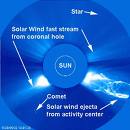 Plasma astrophysicists at the University of Warwick have found that key information about the Sun’s 'storm season’ is being broadcast across the solar system in a fractal snapshot imprinted in the solar wind.
Plasma astrophysicists at the University of Warwick have found that key information about the Sun’s 'storm season’ is being broadcast across the solar system in a fractal snapshot imprinted in the solar wind. This research opens up new ways of looking at both space weather and the unstable behaviour that affects the operation of fusion powered power plants.
Fractals, mathematical shapes that retain a complex but similar patterns at different magnifications, are frequently found in nature from snowflakes to trees and coastlines. Now Plasma Astrophysicists in the University of Warwick’s Centre for Fusion, Space and Astrophysics have devised a new method to detect the same patterns in the solar wind.
The researchers, led by Professor Sandra Chapman, have also been able to directly tie these fractal patterns to the Sun’s ‘storm season’. The Sun goes through a solar cycle roughly 11 years long. The researchers found the fractal patterns in the solar wind occur when the Sun was at the peak of this cycle when the solar corona was at its most active, stormy and complex – sunspot activity, solar flares etc. When the corona was quieter no fractal patterns were found in the solar wind only general turbulence.
This means that fractal signature is coming from the complex magnetic field of the sun.
Comment: This is a remarkable press release and I am very proud of these plasma astrophysicists! They are confirming that the solar wind is delivering information from the Sun in a form that implies a scalar/torsion field with data held as "vibrational energy patterns". Awesome! Is this proof that the Sun is "programming" the Earth & our solar system as part of the ongoing evolutionary changes...
Helium May Set Minimum Speed Limit For Solar Wind
SpaceDaily.com, 18th May 2007

"The solar wind is a diffuse stream of electrically conducting gas (plasma) constantly blowing from the sun."
Comment: I am starting to think that the Electric Universe theorists are winning the theoretical battle! The solar wind speed given here of 260 kilometers per second (161 miles/sec.) is quite low, you can check the
current speed here. The only thing of real relevance to most people, is that we are told once again, "When turbulent solar wind hits Earth's magnetic field, it can cause magnetic storms that overload power lines and radiation storms that disrupt spacecraft." We will all soon know more about this, as Solar Cycle 24 picks up.
Dancing Loops in Profile (May 18, 2007)
SOHO Website, 18th May 2007

This is one of the clearest and most engaging clips of solar plasma shimmying and arcing above the edge of the Sun that we have ever been able to view (May 9-10, 2007). With STEREO's high frame rate (an image every few minutes) and high resolution, we can zoom in on areas of interest yet maintain image clarity. This large sunspot was just rotating to the edge of the Sun when we zoomed in on its action for about 18 hours.
Comment: Nice clips here from the STEREO satellite showing "solar plasma shimmying and arcing above the edge of the Sun". Interesting that they admit to the plasma arcing. Is this a hint that SOHO scientists are finally succumbing to the obvious plasma behaviour advocated by Plasma Universe theorists. This means it's only taken 70 years from when scientists discovered that the outside (Corona) of the Sun was 300 times hotter than the 6000 K surface and theories of the Electric Sun were first proposed.
'Pipe organ' plays above the Sun
BBC News, 20 April 2007

"The coronal temperature is up to 300 times hotter than the Sun's visible surface, or photosphere. And no one can explain why."
Comment: Well that is factually incorrect and plasma physicists can easily explain this as plasma arc discharge, see the book "The Electric Sky" by Prof. Don Scott and www.holoscience.com. What's more the Sun is a huge ball of plasma, not just the corona. There is no proof that nuclear fusion powers the sun and scientists have spent 50 years trying to control nuclear fusion in the laboratory and have failed. At this moment in time, there is not enough of an understanding of the properties of plasma which is a problem, as the Sun is now poised to start detonating huge clouds of plasma in the current process of transforming the Earth.
Scientists Predict Big Solar Cycle
Physorg.com, December 22, 2006
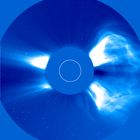
Evidence is mounting: the next solar cycle is going to be a big one. Solar cycle 24, due to peak in 2010 or 2011 "looks like its going to be one of the most intense cycles since record-keeping began almost 400 years ago," says solar physicist David Hathaway of the Marshall Space Flight Center. He and colleague Robert Wilson presented this conclusion last week at the American Geophysical Union meeting in San Francisco.
Comment: Well, the scientists are warning each other about the expected increase in the Sun's activity, but this means very little to the average person. Like effects on GPS and the possiblity of a wide-spread knock-out of power supply.
Sun's Currents of Fire Slow to Record Low
Science@NASA posted: 10 May 2006
 Comment:
Comment: Here, we are being told that the Sun's Great Conveyor Belt has slowed to a record-low crawl, "It's off the bottom of the charts". The Sun generates a cocoon around our solar system by it's magnetic field, maintained by solar activity. If the Sun's activity drops, the Sun will provide less protection against galactic cosmic rays. Evolutionary energies will increase dramatically, Space Weather will become even more of an issue on Earth.




















